


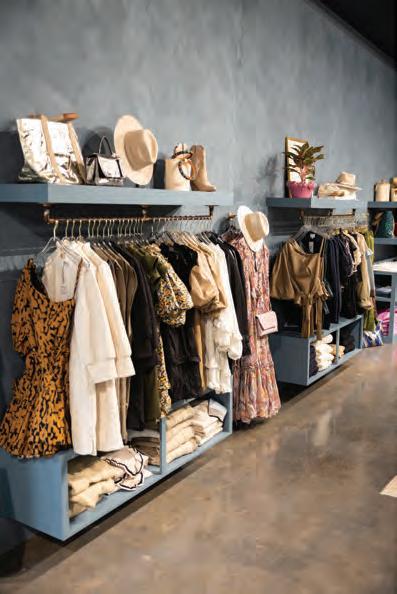
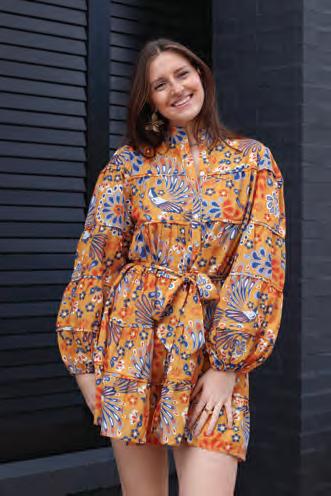



CARNIVAL’S









CARNIVAL’S
From Morocco to New Orleans, a musical odyssey by Alexandra Kennon
From the new guard to the old, the Baton Rouge bluesman is stepping up by John Wirt

The five young women taking over Acadiana’s music scene by Jordan LaHaye Fontenot
Cover image by Brei Olivier
“I’m a New Orleanian,” the Moroccan guitarist and oud player Mahmoud Chouki declares, to his audiences and to his interviewers. He’s now been here for five years, following a lifetime of appearances on international stages in over thirty countries. But New Orleans, and the music made here, is where he has made his home.

It’s a tale as old as jazz itself. Our region has long enticed musicians from far away places—drawn as though by magnets to our vibrant indigenous music scenes, fostering genres steeped in history and local legacy, but bursting with vitality, always transforming and evolving as musicians of new generations and new locales step in to reverently offer their own interpretations.
For this year’s Music Issue, we look at the ways the places we’ve come from and the places we’ve been shape us—as people, and as artists. In our features besides Chouki’s odyssey, we turn to the young women picking up accordions and fiddles as torches of Cajun music and adding their own flare; and to Baton Rouge bluesman Kenny Neal as he continues in the path of greats like Buddy Guy. We hold our ear to our subjects’ pasts, and listen closely for the sounds that come from their own ancestors, or from across the world.
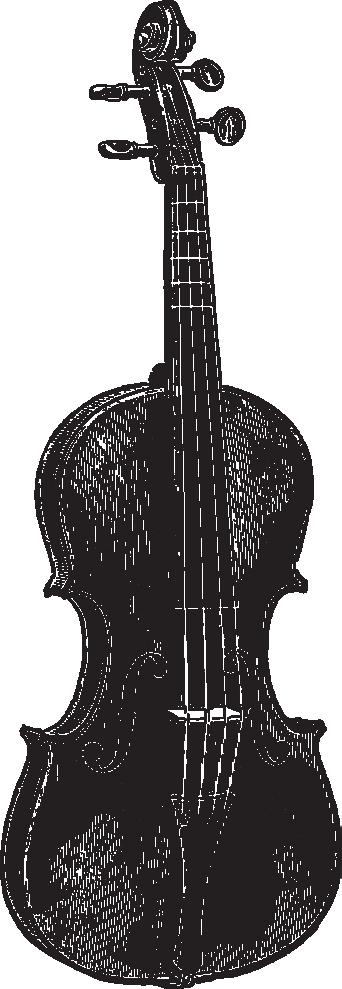
LA BOUCHERIE DE QUARTIER The historic evolution of
WHEN ELVIS WENT BACK TO CHURCH
The Mississippi songwriters behind The King’s most famous gospel hits. by William Browning
RITUAL PBS puts a spotlight on Southern tradition in its new docuseries by Alexandra Kennon
PRETTY, PRETTY, PRETTY An insider look at Big Chief Lil’ Charles Taylor’s creative process by Grete Viddal
100 MEN HALL The iconic Chitlin Circuit venue lives on by Poet Wolfe
INTO THE PASCAGOULA
BD Markey’s paddle excursions foster reconnections with nature by Jason Christian
PERSPECTIVES
Jean Luc & Vanessa Toussaint’s Mask Making Traditions by Jordan LaHaye Fontenot
Publisher James Fox-Smith Associate Publisher Ashley Fox-Smith
Managing Editor Jordan LaHaye Fontenot Arts & Entertainment Editor Alexandra Kennon Creative Director Kourtney Zimmerman
Contributors:
William Browning, Laura Carbone, Jason Christian, Brei Olivier, Jonathan Olivier, Olivia Perillo, Chris Turner-Neal, Grete Viddal, Jo Vidrine, John Wirt, Poet Wolfe
Cover Artist Brei Olivier Advertising
SALES@COUNTRYROADSMAG.COM Sales Team Heather Gammill & Heather Gibbons Advertising Coordinator Melissa Freeman
President Dorcas Woods Brown
Country Roads Magazine
758 Saint Charles Street Baton Rouge, LA 70802 Phone (225) 343-3714 Fax (815) 550-2272
EDITORIAL@COUNTRYROADSMAG.COM WWW.COUNTRYROADSMAG.COM
$21.99 for 12 months $39.58 for 24 months
ISSN #8756-906X
Copyrighted. All rights reserved. No portion of this publication may be reproduced without permission of the publisher. The opinions expressed in Country Roads magazine are those of the authors or columnists and do not necessarily reflect the views of the publisher, nor do they constitute an endorsement of products or services herein. Country Roads magazine retains the right to refuse any advertisement. Country Roads cannot be responsible for delays in subscription deliveries due to U.S. Post Office handling of third-class mail.

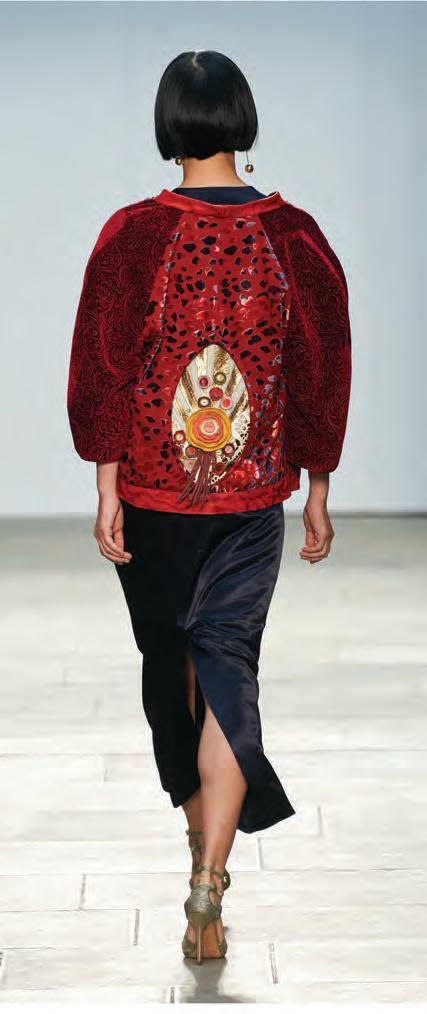
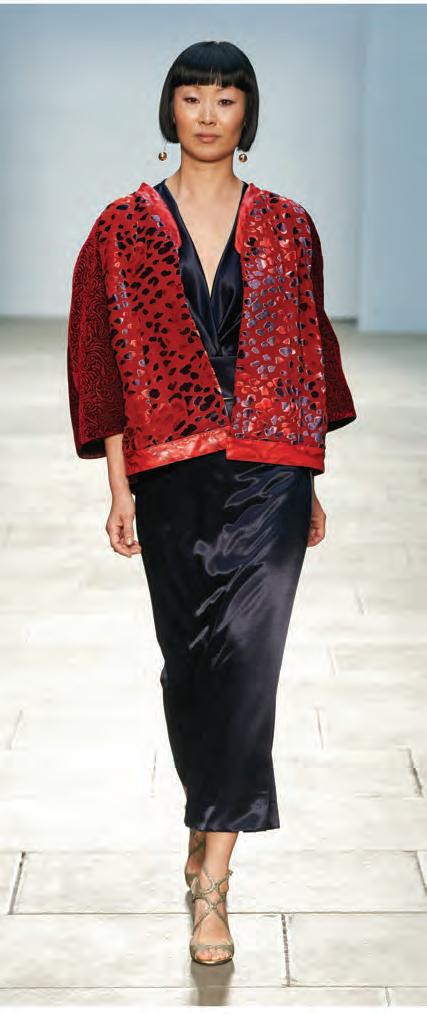
The other day while watching the opening round of the Australian Open tennis tournament, I realized that the first live music concert I ever saw took place on the same patch of ground where Novak Djokovic was at that moment making life miserable for his opponent. Today, that ground is occupied by Melbourne’s Rod Laver Arena, where the Australian Open has been played since the stadium was built in 1988. Prior to that, the site was known as the Melbourne Sports & Entertainment Centre, which as the name suggests, served as a venue for live music concerts when it wasn’t hosting sporting events.
The year was 1986 and the concert was by the British band Dire Straits. A friend and I were taken to it by his father—a man I considered one of the “cool” dads, because he did things like taking his kids to rock concerts, something my own father was about as likely to do as he was to sprout antlers. Our seats were in an altitude-sickness-inducing second balcony, so we spent most of the concert squinting to make out the antlike band-members strutting about the distant stage, bathed in a (for 1986) pretty spectacular light
show. But even from that great height, the event made a powerful impression on sixteen-year-old me. I was awestruck by the energy and showmanship, and transported by the tide of communal goodwill washing through this sea of sweaty strangers.
The experience turned me into a concert junkie, and through the rest of my high school and college years I spent much of my meager disposable income on getting closer to that distant stage. As Australia’s second-largest city, Melbourne was a good town for live music: large enough to justify a stopover whenever a big band set out on a world tour. So, in the late eighties and early nineties, I was fortunate enough to see concerts by iconic performers like Pink Floyd, Bruce Springsteen, The Eurythmics, INXS, the B-52’s; and later, as college sent my musical taste down various esoteric rabbit holes, scores of other acts whose names and song catalogs have long since been consigned to the second-hand record bin of history.
I’m writing this on the verge of flying back to Melbourne to visit my parents—English expats who have called Australia home since a working holiday in 1975 turned into an accidental immigration. Dedicated worshipers of the classical music canon, my parents wore their devotion to the music of the European enlightenment like a shield against the unfamiliar popular culture of the strange new country in which
they found themselves. Consequently, they often seemed dismayed by their teenaged son’s musical taste, which my mother was fond of describing as “a man shouting over the roar of heavy machinery.” And while dad’s record collection did stretch to include the occasional album by a jazz heavyweight like Dave Brubeck or Artie Shaw, I couldn’t imagine any scenario in which he would voluntarily attend a concert by Dire Straits, let alone any of the other, more obscure bands in my obsessively curated catalog.
Often the transition from childhood to adulthood seems set to a soundtrack sure to be considered puerile, unintelligible, or morally repugnant by one’s parents. But perhaps that was the point. When you’re young, music plays a vital role in defining your identity, so loving
songs that your parents can’t stand is a rite of passage—one with the added benefit of keeping them out of the places where you and the rest of your generation are getting on with the business of becoming adults on your own terms.
Here in Louisiana, though, I’m not sure that conventional wisdom holds true, because so many of our most enduring musical genres unite, rather than divide, audiences across the generations. Last spring I went back to New Orleans JazzFest, after a several-year hiatus that was only partially attributable to COVID. It was one of those idyllic late April days—warm and breezy and devoid of the energy-sapping humidity that summer would soon bring. The lineup was classic JazzFest: a few big stars, orbited by a constellation of lesser-known but phenomenally talented acts playing zydeco and blues and jazz and gospel and rap and reggae, and mashups of all the above. The music flooded forth from the stages and tents to an ecstatic reception from fans aged eight to eighty. It was joyous and inclusive and, not for the first time during a Jazzfest afternoon, I found myself wishing my father could be there to see it—certain that he, too, would love this extraordinary demonstration of music’s power to move, regardless of whether or not that music was his own.
—James Fox-Smith, publisher james@countryroadsmag.com




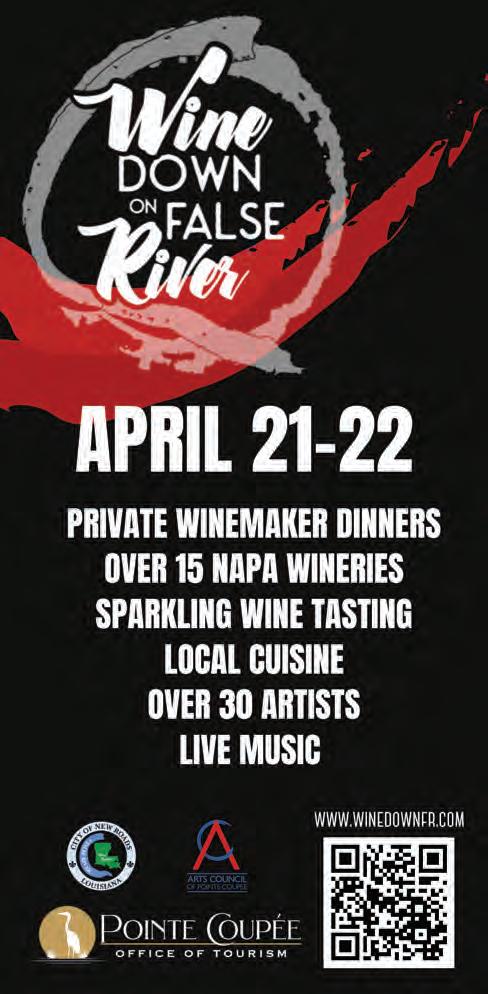
It’s doubtful there’s a more Louisiana way to celebrate finishing a PhD thesis than by choreographing a dance for a Mardi Gras parade, especially when there is an opportunity to use your now-official expertise to infuse new cultural influences into New Orleans’ vibrant traditions.
Soon to complete her English PhD at LSU in Bollywood and Indian Fiction, Ankita Rathour is heading a group of dancers as part of the recently-formed Krewe da Bhan Gras—who will debut
New Orleans Carnival’s first traditional Bollywood performance through the streets as part of the Krewe Bohème Parade on February 3.
Krewe da Bhan Gras was formed with a mission to, “represent the South Asian diaspora in New Orleans,” while “entertain[ing] and inspir[ing] parade-goers with vibrant, upbeat, traditional Indian dance.”
The group of dancers and auxiliary support people (among them Rathour’s husband, Jason Christian, who some-
times contributes to Country Roads), have been taking time from their individual busy schedules to rehearse the Bollywood-style dance twice a week in a St. Claude Avenue space leading up to the big night. “It’s been going really fantastic, to be honest,” Rathour gushed. “How quickly everybody is just grasping the steps has been very impressive for me.”
And as for finishing her thesis, Rathour agrees that a Bollywood-inspired celebration wrapped into a Mardi Gras parade couldn’t be a more fitting conclusion.
IN 2015, SAM IRWIN STARTED A BAND, A BLOG, AND A BOOK
The day after New Orleans Rhythm and Blues icon Allen Toussaint died in November, 2015, musician and author Sam Irwin heard a rendition of Toussaint’s “The Bright Mississippi” played by Grammy-winning trumpeter Nicholas Payton. The music struck Irwin, who hadn’t picked up his own trumpet in thirty years.
This is the story of how Irwin started his band the Florida Street Blowhards, but it is also the story of how he started writing his latest book, The Hidden History of Louisiana’s Jazz Age (History Press)—which began as a collection of blog posts he wrote to promote his new band, and has now emerged as a fully-fledged exploration of jazz music’s history in his home state.
We at Country Roads have had the great pleasure of sharing excerpts from this project over the past year, including the stories behind Louis Armstrong’s first visit to Baton Rouge, and his much-debated birthday. In his book, Irwin deep dives into similarly tantalizing topics, such the biography of Crowley trumpeter Evan Thomas—who was murdered on the bandstand; the history of how jazz found a home miles away from New Orleans in rural Acadiana; and the legacy of Baton Rouge musician and bandleader Toots Johnson.
—Jordan LaHaye FontenotAutographed copies of The Hidden History of Louisiana’s Jazz Age can be purchased at samirwin.net. The book can also be found at arcadiapublishing.com/the-history-press.

Imagine a music streaming platform with the ease and functionality of Spotify—except entirely hcurated by a team of music scholars, with the goal of uplifting New Orleans’s rich collective of artists and providing a listening experience that transmits a tapestry of the city’s one-of-a-kind music scene.
The New Orleans Public Library has done it, launching Crescent City Sounds last fall with a collection of thirty locally-produced albums culled from submissions from New Orleans musicians spanning genres. The curatorial team

included Alison Fensterstock, music journalist and WWOZ DJ; David Kunian, Curator of the Jazz Museum; Holly Hobbs, music consultant and ethnomusicology expert; local rapper Alfred Banks; and Tavia Osbey, co-founder of MidCitizen Entertainment.
From brass band anthems by the Grammy-winning New Orleans Nightcrawlers and the moody funk of Sandra Love & the Reason, to rhymes by rising hip hop star Kaye the Beast and vintage blues originals by Sao Paulo-born guitarist T. Guy—Crescent City Sounds emulates the feeling of walking past a
collection of this music city’s nightclubs, poking your in head each one, and opting to stay awhile.
Local listeners with an interest in getting to know the music created by their neighbors and further supporting it have found a ready-made landing place; while artists enjoy a new avenue for sharing their work right here at home. Artists featured on the platform enjoy a spot there for at least five years, and are paid an honorarium for non-exclusive licensing rights. On the other hand, listeners can enjoy access to the platform free of charge.
“This is like, the best way to graduate,” she laughed. “And I can’t imagine a better culture than New Orleans and a better place than New Orleans to do a Bollywood kind of a fusion dance … I think just, you know, the city is absolutely perfect for like a melting pot of cultures and people just coming and having a good time.” —Alexandra Kennon
Look for the Krewe da Bhan dancing as part of the Krewe Bohème Parade on February 3 at 7 pm. kreweboheme.com
Heather Riley, Circulation and Customer Experience Librarian at the New Orleans Library, said that in addition to the thirty inaugural artists selected for inclusion in 2022, later this year the library plans to add another sixty.
“Crescent City Sounds was the library’s push to sort of start preserving our culture, our current culture,” she said, “as well as our history.”
—Jordan LaHaye FontenotStream music by New Orleans artists for free at crescentcitysounds.org.

Pest control will take on a festive air February 24-25 in Venice during the 2023 Swamp Safari Shootout Nutria Rodeo, where the marsh-destroying nibblers will be the target of squadrons of hunters competing to bag cash prizes for bringing in the most and the biggest nutria. Those who come up short in these categories can still hope for prizes in “best team name,” “best team costume,” and the nutria toss (judged by distance). In 2022, sixty-two teams removed 1,934 nutrias from the Delta, and organizers hope to meet or match that tally this year. After weigh-in, many of the late nutria will be provided to the Audubon Zoo to allow their resident alligators a taste from their wild cousins’ menu.
According to publicist James Haik, while the event is fun, it also draws attention to the swamp and efforts to keep Louisiana’s wetlands intact. Most people know about the damage the invasive nutria population causes, but it’s important to realize that there are ways of addressing the issue. It’s unlikely that Louisiana will ever eradicate the nutria, but keeping the population suppressed can still benefit the swamps and the people who rely on them—which if you count their role in flood control, is effectively everyone south of Alexandria.


Non-hunters are welcome at the event and will have plenty to do—though to keep in the spirit of things, if you see a nutria, give it a dirty look. Cajun music will play both nights and vendors will sell alcohol, crawfish, and other food. The adventurous can sample the products of the nutria cook-off, which appears for the first time in an official capacity after some dabbling in jambalaya and gumbo in previous years. (Per Haik, the meat has the slight gaminess people will recognize from all wild meat, along with the chickeny-but-not-quite-chicken texture of water animals—think frog legs.) Plus, you’ll know you’re cheering on efforts to save Louisiana’s wetlands, one not-so-cuddly critter at a time.
—Chris Turner NealEarly registration is $35 per boat, with day-of registration $45. There is no limit to the number of team members per boat; it’s one boat per team, so no pulling together an armada. Hunters will be required to follow all Louisiana hunting rules and regulations, and those competing for most nutria must get a trapper’s license. (At a bounty of six dollars per tail, the trapper’s license will pay for itself in a half-dozen nutria.) Also of note: all winners will have to pass a polygraph test (visible to the public), so no showing up with nutrias hidden in your waders to pad your figures. Regulations, details, and more information online at nutriarodeo.com.
Frombluestorap,andfromcountrytoclassical,home-grownmusicisaculturalassetthat’softenunderappreciatedinBatonRouge.Butlookcloserand it’seasytoseethatmusicisapowerfulthroughline,withcountlesssongwriters,vocalists,andmusicianscreatingatapestryofexperiencesateveryturn.
In 2019, Newsweek listed Baton Rouge as one of nine “Music Meccas Around the World You Need to Visit,” singling out the Red Dragon and other listening rooms as intimate venues that attract top talent. Baton Rouge is home to a distinct brand of the blues, celebrated annually at the popular Baton Rouge Blues Festival. And Red Stick is the birthplace of scores of rappers who have risen to international fame.

“We have an incredible music culture in Baton Rouge that could place us on the map among the country’s great music cities,” said Renee Chatelain, president and CEO of the Arts Council of Greater Baton Rouge.


One of the clearest examples of this is the Capital City’s jazz heritage, thanks in part to the legacy of jazz icon Alvin Batiste. The pioneering clarinetist performed worldwide, but chose to spend most of his time as a music educator, teaching at Southern University for more than 30 years.
“We learned about music, but we also learned about life,” said musician and recording artist John Gray, who studied jazz trumpet under Batiste. “And while he was teaching, he was always in a state of learning.”
Gray and renowned saxophonist Roderick Paulin, another Batiste student, were recently appointed directors of Southern’s Alvin Batiste Jazz Institute for the Spring 2023 semester.


“It’s a full-circle moment,” said Gray.
Before his death in 2007, Batiste helped found the River City Jazz Coalition, which sparked the creation of the Arts Council of Greater Baton Rouge’s River City Jazz Masters series, now in its 16th season. A prized gig among international jazz performers, the annual series attracts top talent to the city. Some performers also deliver workshops to young musicians.
“It’s on par with Jazz at Lincoln Center,” said Arts Council of Greater Baton Rouge Executive Vice President Jonathan Grimes. “Musicians around the country really aspire to be part of it.”
Batiste would be proud. Over the course of his career, he was recognized for his commitment to music education, earning fellowships from the National Endowment for the Humanities and winning the International Association of Jazz Educators’ Lifetime Achievement Award and the Louisiana Governor’s Award for Outstanding Contribution to Arts Education, among many others.
Scores of students who trained under Batiste still attest to the power of his teaching style.
“I was actually a student at LSU, but I spent more time at Southern playing with him,” recalls Baton Rouge-based Grammy awardwinning composer Mike Esneault, music instructor at Baton Rouge Magnet High School. “Being introduced to him was a life-changing experience. He made you think about music organically, and I still find myself using the one-liners with my students that he used on us.”
Along with Gray, Paulin and Esneault, the lengthy list of Batiste students includes Branford Marsalis, Michael Foster, Randy Jackson, Troy Davis, and dozens more. They form a kind of club of “Bat” disciples, said Esneault.
Baton Rouge Area Chamber President and CEO Adam Knapp says Baton Rouge’s music scene is an important asset in the city’s cultural portfolio that needs to keep growing.
“One of the best ways to keep and attract people is an amazing music scene, grown locally and with lots of great concerts and more venues,” said Knapp. “To grow more artists, it helps to support those music venues where they can earn a living doing what they love.”
“How do we help?” Knapp continues. “See more live shows!”
FROM BIG CITY PARADES TO RURAL PRAIRIE COURIRS, CATCH THESE FESTIVITIES ACROSS THE SOUTH THIS ROWDY, WONDERFUL CARNIVAL SEASON W
Peruse the following pages for Carnival camaraderie in all its forms as we gear up for Fat Tuesday. Laissez les bons temps roulez!

Krewe Bohème: Presided over by the intoxicating Green Absinthe Fairy, Bohème will march through the Marigny and French Quarter under the theme “Love Letter to New Orleans”. 7 pm. kreweboheme.com.
February 4
Krewe du Vieux: This is New Orleans’ only Mardi Gras parade featuring traditional mule-drawn floats, each with its own satirical theme. 6:30 pm. kreweduvieux.org.
‘tit Rex: Miniature size, maximum fun, this walking parade with the petit, handmade floats marches down the median in St. Roch. 4 pm. titrexparade.com. krewedelusion: One of the weirdest parades of the season, krewedelusion is on a mission to save the universe, starting at its center— New Orleans’ French Quarter. 7 pm. facebook.com/krewedelusion.
Krewe of Cork: New Orleans’s wine krewe will be sippin’ and steppin’ through the

French Quarter. 3 pm. kreweofcork.com.
Krewe of Oshun: This krewe includes marching Baby Dolls, a band contest, peacocks, and the goddess of love—all making their way down St. Charles. 6 pm. mardigrasneworleans.com.
Krewe of Cleopatra: The first all-female organization on the Uptown route will roll again. 6:30 pm. kreweofcleopatra.org.
Krewe of ALLA: One of the oldest of the New Orleans krewes, ALLA has been marching in Uptown since the Great Depression. Step out to catch one of their signature genie lamp throws. 7 pm. kreweofalla.net.
Magical Krewe of Mad Hatters: This recently-founded Metairie krewe aimed at capturing the imagination brings Alice in Wonderland to life with colorful lights, costumes, and dance troops on Veteran’s Boulevard. 5 pm. madhattersparade.com.
Knights of Nemesis: The krewe of St. Bernard Parish will make its annual, unforgettable appearance coming down Judge Perez Drive. 1 pm. knightsofnemesis.org.
Krewe of Pontchartrain: Famous for its history of celebrity Grand Marshals, this St. Charles Avenue parade is one of New Orleans’ longest-standing. 1 pm. kofp.com.
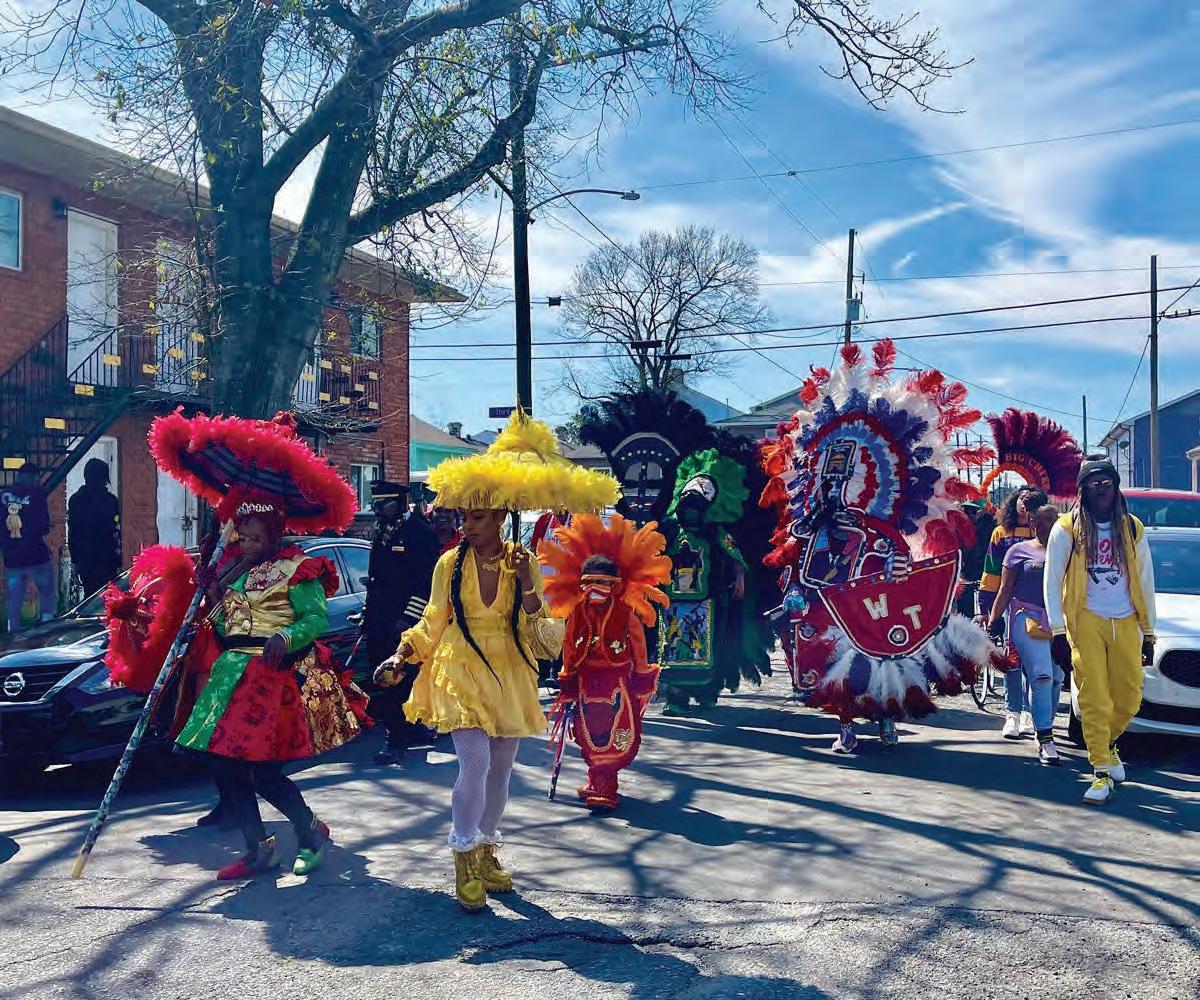
Krewe of Choctaw: Starting their eightyyear history on mail wagons as floats, this krewe will march down St. Charles. 2 pm. kreweofchoctaw.com.
Krewe of Freret: This krewe has a focus of preserving New Orleans Mardi Gras tradition, and will march down St. Charles. 3 pm. kreweoffreret.org.
Knights of Sparta: This all-male krewe has been around since the fifties. 5:30 pm down St. Charles. knightsofsparta.com.
Krewe of Pygmalion: This parade founded by Carnival veterans in 1999 rolls down the St. Charles route around 6:15 pm. kreweofpygmalion.org.
Mystic Krewe of Barkus: This one has gone to the dogs—see them all, including the four-legged royalty, this year with the theme “Top Dogs: Barkus Comes to the Rescue”. In the French Quarter, starting at 2 pm. kreweofbarkus.org.
The Mystic Krewe of Femme Fatale: The first krewe founded by African American
Parades and more in Greater New Orleans & Acadiana
women for African American women, their signature throw is a designer compact. 11 am down St. Charles. mkfemmefatale.org.
Krewe of Carrollton: The fourth-oldest parading krewe of New Orleans, known for throwing shrimp boots. Noon down St. Charles. kreweofcarrollton.org.
Krewe of King Arthur and Merlin: One of the largest New Orleans krewes, Arthur and Merlin’s signature throw is the King Arthur Grail——hand-made goblets that are bestowed upon the most esteemed parade-goers. Follows Carrollton at 1 pm. kreweofkingarthur.com.
Krewe of Druids: This secret society is known for its wit and tendency to ruffle feathers. One year it featured a float saying: “Seriously...The Parade Behind us is not Worth the Wait.” 6:15 pm down St. Charles. mardigrasneworleans.com.
Knights of Babylon: Traditional to the max, this Uptown krewe designs their floats exactly as they were drawn up over eighty years ago. The king’s identity is never revealed to the public. 5:30 pm. knightsofbabylon.org.
Knights of Chaos: Chaos carries on the grand tradition of satire, following Babylon on the Uptown route at 6 pm. mardigrasneworleans.com.
Krewe of Muses: Let’s get some shoes—one of the most coveted throws of the season comes from this incredibly popular allfemale parade. 6:45 pm. kreweofmuses.org.
Krewe of Bosom Buddies: This French Quarter walking parade celebrates women of all walks of life, and throws out hand-decorated bras. 11:30 am. bosombuddiesnola.org.
Krewe of Hermes: Every year, the Hermes captain leads the Uptown procession in full regalia on a white horse, followed by innovative neon floats and 700 male riders. 5:30 pm. kreweofhermes.com.
Krewe d’Etat: Led by a dictator instead of a king, this secret society gets a kick out of throwing blinking skulls at its audience. Pick up a copy of the D’Etat Gazette, a bulletin with pictures and descriptions of the floats. 6:30 pm down St. Charles. mardigrasneworleans.com.
Krewe of Morpheus: Looking through the chaos and tomfoolery for an “old school” parade down St. Charles? This one’s for you. 7 pm. kreweofmorpheus.com.
Krewe of NOMTOC: The Krewe of New Orleans Most Talked of Club was founded in 1969 by the Jugs Social Club. The all-
Black krewe tosses out ceramic medallion beads, jug banks, and signature Jug Man dolls. Starts on the Westbank at 10:45 am. nomtoc.com.
Krewe of Iris: One of the oldest and largest female Carnival organizations for women, Iris members continue to follow tradition with white gloves and masks. 11 am down St. Charles. kreweofiris.org.
Krewe of Tucks: This one’s developed a reputation for its potty humor, including toilet paper throws draping St. Charles’s live oaks. Noon. kreweoftucks.com.
Krewe of Endymion: If you’re heading to
parade, and evolved into the over 250-rider krewe it is today, traveling on the traditional Uptown/Downtown route. 11 am. kreweofokeanos.org.
Krewe of Thoth: This year, the theme of this inclusively-routed parade that goes by healthcare facilities is “Thoth’s Diamond Jubilee.” Noon on the Uptown route. thothkrewe.com.
Krewe of Athena: Jefferson Parish’s newest all-female krewe will be tossing out hand-decorated fedoras down Veteran’s Memorial Boulevard. 5 pm. kreweofathena.org.
Krewe of Atlas: This Metairie Krewe was founded on the principle of equality for all. 5:30 pm down Veterans. mardigrasneworleans.com.
parades. 8 am on St. Charles. kreweofzulu.com.
Krewe of Rex: Elaborately decorated, handpainted floats, masked riders in historic costumes, and a rich and colorful history make Rex one of the cultural centerpieces of Mardi Gras. Rex was formed in 1872, making it the oldest continually-operating krewe. The identities of Rex’s king and queen remains secret until Lundi Gras. 10 am down St. Charles. rexorganization.com.
Black Masking Mardi Gras Indians: See the intricate hand-beaded-and-feathered suits—traced back to the Native Americans who helped Africans enslaved in New Orleans escape—when dozens of tribes take to the streets Uptown, usually around 2nd and Dryades streets; and downtown, often near the Backstreet Cultural Museum in the Treme late morning to mid-day. Free.
Elks, Krewe of Orleanians: The world’s largest truck parade features over fifty individually designed truck floats and comprises of over 4,600 riders. Follows Rex at 10:30 am. neworleans.com.
Krewe of Crescent City: Each truck in the Crescent City Truck Parade represents a different Carnival organization. This parade signals the official “beginning of the end” of Carnival. Follows ELKS Orleanians at 11 am. crescentcitytruckparade.com.
One of Jefferson Parish’s largest and most family friendly parades, Argus draws over a million revelers to the Veterans Memorial Parade Route in Metairie. Past celebrity guests include Barbara Eden, Phyllis Diller, and Shirley Jones. 10 am. kreweofargus.com. Elks, Krewe of Jeffersonians: Featuring more than ninety trucks and 4,000 riders, this krewe shares the Elk mascot with its sister krewe, the Krewe of Elks-Orleanians. 11 am on the Veterans Memorial Boulevard route. neworleans.com.
organization and largest all-female krewe, the Metairie Egyptian-themed parade features marching bands, dance teams, and spectacularly-attired maids. Starts at the Esplanade Mall at 6 pm. kreweofisis.org.
Krewe of Bacchus: Revered as one of the most spectacular krewes in Carnival history, this parade is known for staging celebrities Bob Hope, Dick Clark, WIll Ferrell, and Drew Brees as its namesake, Bacchus. The parade ends inside the Convention Center for a black-tie Rendezvous party of over 9,000 guests. 5:15 pm. kreweofbacchus.org.
Krewe of Mid-City: This one is famed for its foil-covered floats and children-oriented themes. 11:25 am along the St. Charles Route. kreweofmid-city.com.
Krewe of Okeanos: Back in the fifties Okeanos started as a small neighborhood
established as a super krewe immediately after its debut, which rolled out 700 riders, and celebrates forty years this year. This year, monarchs include Golden Globewinner Darren Chris and pop icon Joey Fatone. Fatone will headline Orpheusapade, the post-parade gala which is open to the public. Rolls on the Uptown route at 6 pm. kreweoforpheus.com.
Krewe of Centurions: The family-friendly Centurions parade is comprised of over 350 men, and rolls on the Metairie route. 6:30 pm. kreweofcenturions.com.
Krewe of Zulu: A parading krewe since 1909, Zulu was the first and for many years the only krewe representing New Orleans’ Black community. Its extraordinary costumes, float designs, and history distinguish it from other Mardi Gras
Featuring trucks and unique throws, the Krewe of Jefferson follows the Elks Krewe of Jeffersonians to signal the “beginning of the end” of Carnival in Jefferson Parish. 11:30 am. kreweofjefferson.com. k
Bayou Mardi Gras Association Parade: This family-oriented parade runs along Bayou Teche in historic New Iberia, energized by community leaders committed to building on past traditions while creating new ones. 7 pm. bayoumardigras.com.

La Danse de Mardi Gras: The Acadiana Center for the Arts in Lafayette celebrates rural Cajun Mardi Gras traditions with this country dance, including commentary about local traditions by American Routes Host Nick Spitzer, lively music by Steve Riley and the Mamou Playboys, Cedric Watson,


and Jeffrey Broussard, as well as dinner by Tony Chachere’s chefs. $35-$500. 5 pm. acadianacenterforthearts.org.
Krewe de Canailles: Celebrating inclusivity, creativity, and sustainability, this walking parade down Jefferson Street in Lafayette does allow for floats—if you drag them yourself. Tossing out eco-friendly throws and joining together groups of sub-krewes, these carnival crusaders have found a way to party their way to a better Lafayette. This year’s theme is “There’s Something in the Water”. 7 pm. krewedecanailles.com.
Lakeview Park & Beach Children’s Mardi Gras: Immerse your tots in the traditional Mardi Gras experience at Lakeview in Eunice, where chickens will be set loose for chasing, and live music will usher in a two step. lvpark.com.
Lebeau Mardi Gras: It starts with an old-school courir that includes the addition of a greased pig, and zydeco tunes. Then the Lebeau Mardi Gras Parade welcomes participants on horse, ATV, automobile,
wagon, or a traditional float. Festivities start at 8 am, parade departs at 1 pm and ends at a music fest at the Immaculate Conception Church. cajuntravel.com.
Courir de Mardi Gras de L’anse: Come for the run, stay for the fais-do-do and gumbo afterwards at a home on Lafosse Road, which the public is invited to enjoy. Courir begins at 8 am, Fais Do Do at 4 pm. $5. acadiatourism.org.
Krewe Des Chiens: The least we can do for our dogs is to parade them, in all their grandeur, through the streets of Lafayette. Noon on West Vemilion Street. krewedeschiens.org.
Lake Arthur Mardi Gras Run/Parade: Bringing the extravagance of Carnival right up beside the old Acadiana traditions, Lake Arthur’s celebration includes both floats and riders on horseback. The courir-style run begins at 9 am from Lake Arthur Park, followed by the float parade at 2:30 pm. jeffdavis.org.
Krewe of Carnivale en Rio: Known for its vibrant floats, dazzling lights and the jubilant accompaniment of maracas, the Parada—which honors Brazil’s first emperor Dom Pedro I and his granddaughter Dona Isabel—has become
Lafayette’s premier Mardi Gras event. 6:30 pm down Johnston and Vermilion. riolafayette.com.

Courir de Mardi Gras at Vermilionville: Vermilionville and the Basile Mardi Gras Association host a traditional Cajun Mardi Gras run in the historic village. Begins at 10 am with a screening of Pat Mire’s documentary Dance for a Chicken, followed by a presentation on the traditional “Chanson de Mardi Gras” at 11 am. The run kicks off at 11:30 am. $10; $8 for seniors; $6 for students; and children younger than five are free. bayouvermiliondistrict.org. Scott Mardi Gras Parade: This small town parade is one of Acadiana’s largest, and a favorite for families city-wide and beyond. Floats and costumed riders will vie en fete for the title “Most Original Float.” 1 pm. scottsba.org.
Greater Southwest Louisiana Mardi Gras Kick-Off Parade: Getting things started for the slate of events that makes up the Association’s celebration of Mardi Gras in Lafayette, this parade travels through the Downtown area to land at Cajun Field. This year’s theme honors Lafayette’s Bicentennial with a celebration of the city’s festivals. 6:30 pm. gomardigras.com.
Le Festival de Mardi Gras à Lafayette: Head to Cajun Field in Lafayette for Carnival rides and games, and live music like Wayne Toups, the Chee-Weez, Three Thirty Seven, and more. gomardigras.com.
Eunice Cajun Mardi Gras Festival: In the days leading up to Eunice’s historic courir on Mardi Gras Day, the city convenes downtown for five days of fais do-doing. Some of the acts to look forward to include Wayne Toups, T’Monde, Steve Riley & the Mamou Playboys, and Geno Delafose & French Rockin’ Boogie. Don’t miss the open jam session Saturday morning, or the traditional boucherie by the Pa Ta Sa Krewe on Sunday. Expect to watch the end of Eunice’s courir come through town at 3 pm Tuesday afternoon. eunicemardigras.com.
Cankton Courir de Mardi Gras: A chicken run, trail ride, gumbo cook-off, live music, and more at Landon Pitre Memorial Park. 7 am. $10 to participate in each event; proceeds benefit the Special Olympics of Louisiana. facebook.com/cccdmg.
Mamou Street Dance: Saturday mornings are always a riot in Mamou, but the Saturday before Mardi Gras is something
else entirely. Find traditional music in Fred’s Lounge, then step outside and find it in the street, too—along with a crowd of eager and dedicated locals who will show you how it’s all done. 9 am. evangelineparishtourism.org.
Church Point Children’s Courir & Parade: A children’s chicken run, with all the trappings, at Saddle Tramp Clubhouse. For children younger than fourteen. Starts at 10 am. churchpointmardigras.com.
Jennings Mardi Gras Festival & Parade: Strolling along since 1994, this parade is marked on both ends by festive food and family-style activities, including live music, home-style food, and crafts. Starts at 11 am in Founders’ Park with the Squeezebox Shoutout Cajun Accordion Championship; Parade on Main Street begins at 4:30 pm. louisianatravel.com.
Sunset Mardi Gras Parade: Sunset Mardi Gras has continued on as a Carnival classic with beads, doubloons, and live music— along with children’s activities. 11 am. sunsetmardigras.com.
Lafayette Children’s Parade: The city’s tiniest krewes will head down Johnston at 12:30 pm. gomardigras.com.
Eunice Parade of Paws: Come see the pups parade through Downtown Eunice, then catch Fred Charlie & the Acadiana Cajuns on the bandstand. 3 pm. eunicemardigras.com.
Rayne Mardi Gras Parade: Everyone is invited to be in Rayne’s annual parade— walkers, drivers, and floaters alike. Starts at American Legion Drive, ends at the Frog Fest Pavilion. 3 pm. raynechamber.net.
Lafayette’s Krewe of Bonaparte: A hallmark since 1972, this krewe infuses excitement and youth into the city’s traditions. See them roll from Jefferson to Johnston, to the Cajun Dome, starting at 6:30 pm. gomardigras.com.

Courir de Mardi Gras Church Point: Once named “The Best Traditional Mardi Gras,” this run features costumed horseback riders, wagons, buggies, floats, and live music along with all your characteristic chicken chasing and greased pig capturing. 8 am–1:30 pm. $40, must be in costume to participate. Main Street parade begins at 1 pm. churchpointmardigras.com.
Eunice Lil’ Mardi Gras: Watch the lil’ costumed runners race after the courir’s mascot—fueled by the promise of a chicken-shaped trophy. $10 per child; $10 per vehicle to follow along the route. Begins at 9 am at the Eunice Recreation Complex, followed by the official chicken chasing competition at 1:15 and the children’s parade through downtown at 3 pm. facebook.com/ eunicelilmardigras.
Sunset Kids Wagon Parade & Family Fun Day: This inaugural parade begins and ends at the Sunset Community Center, featuring decorated wagons and children decked out for theme of “Alice in Wonderland” 1 pm. Stick around from 2 pm–4 pm for live music
and food behind the Community Center. Free. sunsetmardigras.com.
Grand Marais Mardi Gras Parade: Admire costumes from the artistic to the repulsive—all elaborate, plus floats and dance troops at this family-friendly Jeanerette parade, which begins at Grand Marais Park at 2 pm. iberiatravel.com.
Lundi Gras at Lakeview: Lakeview Park & Beach know how to throw a party, and their free Lundi Gras pig roast is no different. Get your fill, then stick around for live music by Jamming with Bird and Cajun Fire, then the traditional barn dance with Geno Delafose & French Rockin’ Boogie from 4:30 pm and Steve Riley & the Mamou Playboys at 7 pm. lvpark.com.
Lafayette’s Monday Night Parade: Evangeline LXXXII and LXXXIII will reign over the city’s most regal krewes, rolling down the Southwest Louisiana Mardi Gras route at 6 pm. gomardigras.com.
Courir de Mardi Gras de Grand Mamou: One of the most raucous and famous chicken runs on the prairies gets its start at 6:30 am, and travels throughout the country roads collecting goods for that end-of-theday gumbo. Catch the parade at the end of the day in downtown Mamou around 3 pm. evangelineparishtourism.org.
Faquetaigue Courir de Mardi Gras: Founded in 2006 by friends Joel Savoy, Linzay Young, Jesse Brown, Lucius Fontenot, Lance Pitre, and Dave Johnson— this courir celebrated on the outskirts of Eunice holds values of tradition, as well as inclusivity, at its heart. Designed to be appropriate for all ages and to emphasize culture—the run takes place on horseback, on foot, and via trailer, journeying throughout the Faquetaigue community. Dancing, begging, and singing are aplenty, all leading up to a traditional gumbo and concert at the day’s end. Begins at 8 am; full costumes with hats and masks are required. $20. faquetaigue.com.
Le Vieux Mardi Gras de Cajuns de Eunice: Dating back to the city’s earliest days, Eunice’s Courir de Mardi Gras features riders on horseback in masks, conspiring in chicken-chasing, revelry, general silliness, and an effort to make a community-wide gumbo. Costume-clad trailers follow behind—and all join together in downtown Eunice for a final fais do do at 3 pm. The day starts at 8 am at the Northwest Community Center. facebook.com/eunicemardigras.
Tee Mamou-Iota Mardi Gras Folklife Festival: Featuring all your favorite traditions, the handmade costumes, the medieval capuchins, and the unbridled chaos—the Folklife Festival also celebrates with live music, folk crafts, and local food booths on the prairie. 9 am–4 pm. acadiatourism.org.
Carnival D’Acadie: Run into the heart of
Parades and more in the Capital Region & Cajun Coast

the Cajun Prairie to celebrate Fat Tuesday, Rice City Style. Crowley’s Fat Tuesday festival includes carnival rides, live music by Wayne Singleton, Swampland Revival, Adam Leger Band, and Dustin Sonnier— plus a grand parade at 2 pm. Music starts at 10 am. acadiatourism.org.
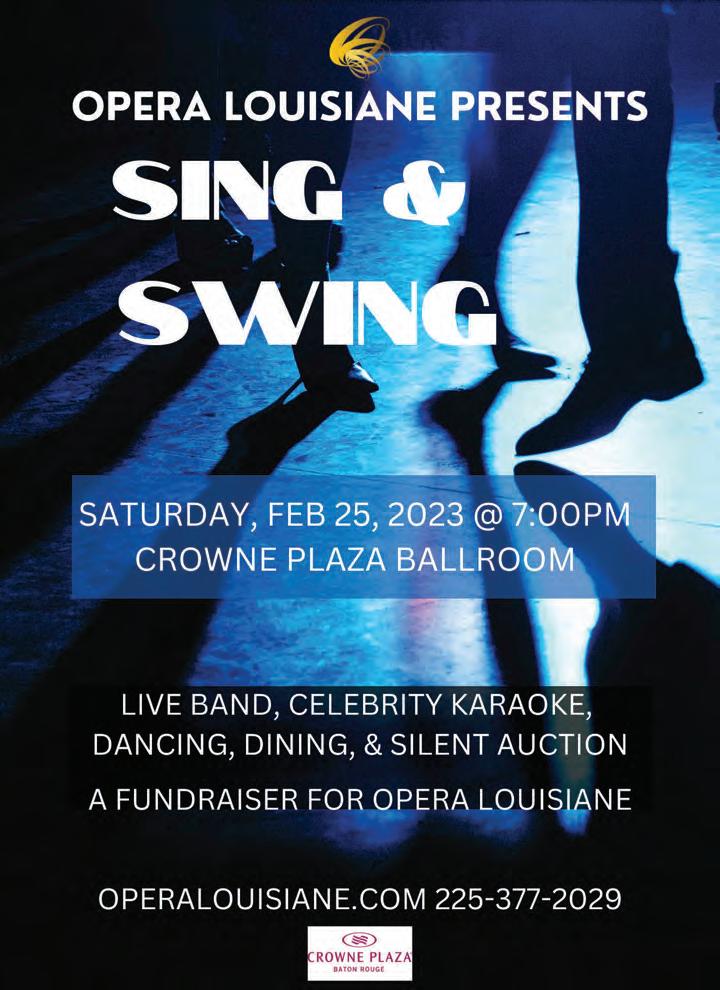
King Gabriel’s Parade: Lafayette’s grandest of parades, honoring the King of Carnival and the hundreds of volunteers who make the vibrant showcase down Johnston possible. 10 am. gomardigras.com.
Opelousas Imperial Mardi Gras Parade: Floats, beads, and reigning royalty make up this Opelousas parade. Rolls from East Landry Street to Liberty Street beginning at 11 am. cajuntravel.com.
Lafayette Mardi Gras Festival Parade: Emitting the spirit fueled by the Carnival atmosphere at Cajun Field, this parade will run down Johnston at 1 pm. gomardigras.com.
Lafayette’s Mardi Gras Indians: Replicating the better-known Black Masking Indians of New Orleans, Lafayette’s tribes have cultivated their own distinct traditions since the 1950s. See the elaborate costumes and the invigorating spirit of the tradition on display at “Pontiac Point” (the corner of
Simcoe and Surrey Streets) at 1 pm, and again at the Judging Contest at Clark Field at 3 pm. lafayettetravel.com.
Independent Parade: Anyone can participate in this parade, which closes out Mardi Gras day in Lafayette. Take part, or enjoy the show of “independent” floats rolling down Johnston, starting at 2:30 pm. gomardigras.com. k
Krewe of Oshun Parade and Festival: Find Carnival games, eating contests, and other free family fun at BREC’s Scottlandville Parkway Conservation Park for this third annual festival and parade—which features bands, dance teams, schools, businesses, and non profits in addition to entertainers and krewe members’ floats. Rolls at noon, festival carries on from 2 pm–6 pm. visitbatonrouge.com.
Mystic Krewe of Mutts: Bark your calendars for the CAAWs Mystic Krewe of Mutts parade, held in downtown Baton Rouge. Bark in the Park events begin at 10 am, and the parade rolls at 2 pm. caaws.org.
Krewe of Artemis: The first all-female krewe in Baton Rouge begins and ends at the corner of St. Philip Street and Government Street. Revelers will be treated to the Krewe of Artemis’ signature highheeled shoe. 7 pm. kreweofartemis.net.
Krewe of Diversion Boat Parade: Set sail in sin for Livingston Parish’s parade on the Amite River/Diversion Canal. Noon. Live auction at Manny’s after the parade benefitting St. Jude Children’s Research Hospital. (225) 939-2135.
Krewe Mystique de la Capitale: Baton Rouge’s oldest parading Mardi Gras krewe continues its mission to uphold Carnival season in the Capital City. Fun for all ages, it starts at the River Center and winds downtown. 2 pm. krewemystique.com.

Krewe of Tickfaw Mardi Gras Boat Parade: Mardi Gras comes to the Tickfaw River with boats decked out in ways unimaginable. 2 pm. Details at the Krewe of Tickfaw-Mardi Gras on Tickfaw Facebook Page.
Krewe of Ascension Mambo Parade: Prepare to be awed as the creative masterpieces that are Ascension Parish’s Mardi Gras floats pass down Irma Boulevard to the corner of Highways 44 and 30. 2 pm. Details at the Krewe of Ascension Mambo Facebook Page.
Krewe of Denham Springs: The Antique Village comes to life with people throwing trinkets at each other at noon from Denham Springs High School, and ends at Veteran’s Boulevard. Stick around for the first-annual Mardi Gras Mambo celebration in the Village, featuring food trucks and artists Clay Cormier, Chase Tyler Band, and Thomas Cain. 3 pm. Free. livingstontourism.com.
Krewe of Orion: A Carnival-themed tractor pull through downtown Baton Rouge. Begins and ends at the River Center, where the after-party masquerade will be held. 6:30 pm. kreweoforion.com.
Mid City Gras: Baton Rouge’s freshest Mardi Gras parade returns to Mid City. The one-afternoon revel down North, from 22 Street to Baton Rouge Community College, invites locals to “get nuts,” featuring Mid City artists, musicians, and more in a neighborhood strut. 1 pm. midcitygras.org.
Krewe of Southdowns: Catch this nighttime parade glittering and glaring along its usual route from Glasgow Middle School through the Southdowns neighborhood. 7 pm. southdowns.org.
Baton Rouge Mardi Gras Festival: An incredible line-up from Henry Turner Jr.’s
Listening Room in North Boulevard Town Square is the highlight of this familyfriendly Mardi Gras celebration This year catch acts including Pastor Leon Hitchens, Eddie “Cool” Deemer, The Soul Revival Band, and Henry Turner Jr. & Flavor. 10 am–7 pm. Free. ultimatelouisianapar. wixsite.com/brmardigrasfest.
Spanish Town Parade: Spanish Town’s annual parade of miscreants rolls from Spanish Town Road and Fifth Street, to Lafayette Street and Main. The krewes dole out dozens of infamously-irreverent floats, with marching bands, dance troupes, and waves of pink throws. This year’s theme is “Man I Love Flamingos.” Noon. mardigrasspanishtown.com.
Krewe of Good Friends of the Oaks Parade: Residents of the Port Allen community “The Oaks” established this krewe in 1985, and it has been rolling right along ever since. 1 pm. westbatonrouge.net.
Krewe of Comogo Night Parade: See Plaquemine like you never have before when Comogo rolls, sure to dazzle. 7 pm down Bellevue Drive. kreweofcomogo.com.
Lundi Gras at Circa: Circa 1903, the event center associated with Morel’s in New Roads, continues its tradition of hosting a Lundi Gras bash. 7 pm. $100. bontempstix.com.
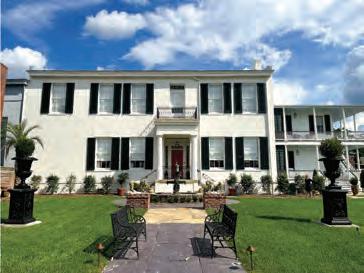



Community Center of Pointe Coupee Parade: Every year for 101 years now the population of New Roads multiplies tenfold as parade-goers searching for a more laid-back time flock to the “Little Carnival Capital”. Rolls at 11 am through downtown New Roads.
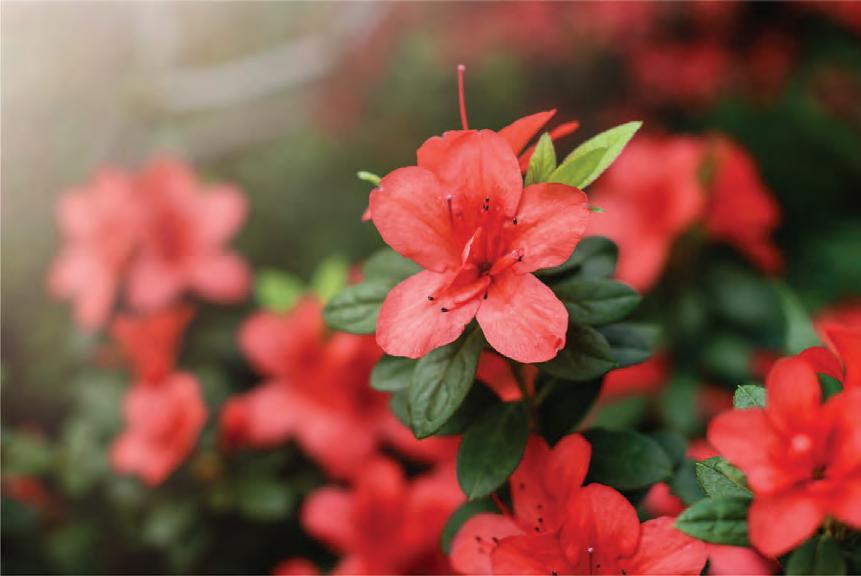

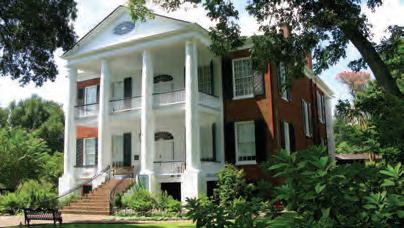
New Roads Lion Club Parade: This beadheavy annual parade follows right behind the Community Center of Pointe Coupee Parade. 2 pm. pctourism.org. k
Bayou King Cake Festival: A sugary new Carnival celebration is making it’s way to Downtown Thibodaux this year, bringing together local bakeries to present a tasting tableaux of local king cakes—introduced by a children’s parade. Enjoy live music from Nonc Nu and Da wild Matous, and cast your vote for the best king cake. All funds benefit the Lafourche Education Foundation. 1:30 pm. $10 facebook.com/ lafourcheeducationfoundation.
February 10












Krewe of Hercules: A favorite along the traditional West Side Route in Houma, Hercules celebrates its thirtysixth anniversary this year. 6 pm. kreweofhercules.com.
Krewe of Shaka: Noted for its
contributions to the community, the King and Queen of this parade are annually presented with the Key to Thibodaux. 12:30 pm in downtown Thibodaux. lacajunbayou.com.
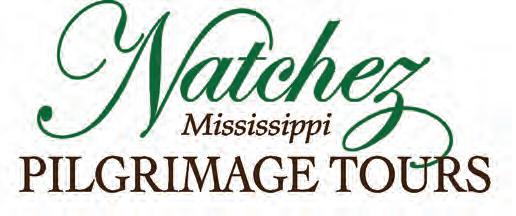
Krewe of Ambrosia: A funky Thibodaux time, this parade has floated through town for over thirty years. 2 pm. lacajunbayou.com.
Krewe of Hyacinthians: The Ladies Carnival Club, Inc. is the largest carnival club in Terrebonne Parish, and surely not a force to be reckoned with. Kicking off at 12:30 down Houma’s West Side Route. hyacinthians.org.
Krewe of Titans: Also dubbed the “Terrebonne Family Carnival Club,” this parade welcomes festivalers of every kind. 1 pm down Houma’s West Side Route. Details at the Krewe of Titans “Terrebonne Family Carnival Club” Facebook Page.
Krewe of Adonis: St. Mary’s first parade of the season is this historic night parade in downtown Morgan City. 7 pm. louisianatravel.com.
Cypremort Point Boat Parade: Spend the day at Cypremort Point State Park, watching the iconic boat parade pass by. 1 pm. cajuncoast.com.
Krewe of Cleophas: Thibodaux’s oldest parade will march again, featuring over fifty floats, bands, stilt walkers, dance teams, and more. 12:30 pm. lacajunbayou.com.
Krewe of Chronos: One of Thibodaux’s most celebrated parades of the season, Chronos believes in the slogan “Every Man a King,” and “Every Woman a Queen.” 1:30 pm. kreweofchronos.com.
Krewe of Galatea: St. Mary’s first female Krewe has been rolling the streets of Morgan City since 1969. Begins on 2nd Street, through downtown, and lands at the Morgan City Auditorium. 2 pm. cajuncoast.com.
Krewe of Cleopatra: The six hundred plus ladies of Cleopatra steal the night for the only Lundi Gras parade in Terrebonne Parish. 6:30 pm down Houma’s West Side Route. houmatravel.com.
Krewe of Hera: One of the Cajun Coast’s newer parades, this Morgan City procession is all excess and excitement. See them heading down Second Street to Onstead to the auditorium on Myrtle. 7 pm–9 pm. louisianatravel.com.
Krewe du Gheens Celebration and Parade: Kicking off Mardi Gras day in
Parades and more in North Louisiana & beyond

the Cajun Bayou region, the Krewe of Gheens will roll at 11 am, beginning on Gheens Shortcut Road. lacajunbayou.com.
Krewe of Ghana: Fun floats and dancers will make their way through downtown Thibodaux on Mardi Gras Day. Noon. lacajunbayou.com.
Krewe of Houmas: This historically-rich krewe was the first to ever parade down Houma’s West Side Route. On each float, family is honored with at least one fatherson duo or pair of brothers. 1:30 pm. kreweofhoumas.wildapricot.org.
Krewe of Hephaestus: The oldest krewe in St. Mary Parish dates back to 1914, rolling on Mardi Gras day from Sixth and Sycamore to the Morgan City Municipal Auditorium. 2 pm. cajuncoast.com. k
February 4
African American History Parade: This thirty-fourth annual parade celebrating the many contributions of Black Americans starts at the Shreveport Municipal Auditorium at 11 am. sbfunguide.com.
Krewe de Riviere Children’s & Pet Parade: This parade includes a bunch of
fantastic beasts and little ones, too. 10 am starting at South Grand Street in Monroe. monroe-westmonroe.org.
Krewe de Riviere Mardi Gras Parade: Enjoy a traditional feel with floats, walking groups, riding groups, and plenty of goodies. Starts at West Monroe High School and ends around the Ouachita Parish Courthouse. 5 pm. monroe-westmonroe.org.
Krewe of Centaur: The largest parade in the Ark-La-Tex area, Shreveport’s “Fun Krewe” is known for its celebration of the regional gambling industry. 3:30 pm starting downtown and traveling down the Shreveport-Barksdale Highway, to E. Kings Highway, ending just before Preston. kreweofcentaur.org.
Krewe of Janus Children’s Parade: A cute parade with even cuter riders at Pecanland Mall’s Center Court in Monroe. 9:30 am. kreweofjanus.com.
Krewe of Janus: Celebrating forty years, Northeast Louisiana’s oldest parade joins the Twin Cities by parading through West Monroe and Monroe, mostly down Louisville Avenue. 6 pm. kreweofjanusonline.com.
Krewe of Paws Parade: Furry friends of all shapes and sizes will be in West Monroe dressed in their Mardi Gras best, beginning on the 100 block of Commerce Street. 1 pm. monroe-westmonroe.org.
Krewe of Barkus and Meoux: The crowd acts like animals for this Shreveport favorite, themed “Krewe of Barkus and Meaoux Gets Geek’d”. 11 am at the Louisiana State Fairgrounds. facebook. com/theanimalkrewe. Parade takes off at 11 am. barkusandmeoux.com.
Krewe of Gemini: Shreveport and Bossier City’s first modern krewe. Downtown Shreveport at 3 pm. kreweofgemini.com.
Krewe of Highland: Lunch will be supplied at this eclectic Shreveport parade in the form of grilled hot dogs and packaged ramen noodles hurled off of floats. After, enjoy live music, crawfish, and more at the Mardi Gras Bash at Marilynn’s. Rolls at 2 pm through the Highland neighborhood. kreweofhighland.org.
East Bank Golf Cart Parade: Golf carts will be decked out when this fun parade (with prizes for the best-decorated carts) returns to Bossier City. 7 pm in the East Bank District and at the Plaza. shreveport-bossier.org. k
Krewe of Bilge: For the Northshore’s marine-Mardi Gras, the boats of the Krewe of Bilge travel down the waterways of Slidell, starting at the Marina Cafe and ending at the Dock of Slidell. Noon. kreweofbilge.com.
Krewe of Poseidon: Themed “Carnivals, Around The World,” this year’s parade will feature around twenty-five floats traveling down Ponchartrain Drive in Slidell. 6 pm. poseidonslidell.com.
Krewe of Pearl River Lions Club: Celebrate the season with floats, the Pearl River High School Band, dance groups, cheerleaders, churches, and families. 1 pm starting at Pearl River High School, heading south on Highway 41 then east to Highway 11, and ending at Town Hall. louisiananorthshore.com.
Krewe of Eve: It began with six women, and now has over five hundred members. With Blaine Kern floats, this parade begins on LA-22 and continues down West Causeway Approach above Monroe Street, crossing 190 and ending on East Causeway Approach. 7 pm. kreweofeve.com.
Krewe of Push Mow: A group of artists in Abita Springs decided it would be
Card. The Right Care.
Childhood comes and goes in a blink. We’re here through the stages of your life, with the strength of the cross, the protection of the shield. The Right
a hoot if they decorated lawn mowers for a parade (spoiler alert: it is). Noon starting on Main Street. facebook.com/ abitaspringspushmowparade.
Krewe of Tchefuncte: This boat parade celebrates maritime life on Madisonville’s historic Tchefuncte River. 1 pm. kreweoftchefuncte.org.
Krewe of Olympia: For the oldest parade in St. Tammany, King Zeus’s identity is kept secret until the parade, which starts on Columbia Street in Covington. 6 pm. kreweofolympia.net.
Krewe of Dionysus: Named for the Greek God of wine, Slidell’s first all-male krewe will set out at 1 pm on Berkley Street. kreweofdionysus.com.
Krewe of Selene: Slidell’s only all-female krewe tosses out one-of-a-kind handdecorated purses. Rolls at 6:30 pm down Pontchartrain Drive and Front Street. kreweofselene.net.
Carnival in Covington: Covington’s main parade includes full-sized floats, hand-built floats, marching bands, dancers, walking groups, horses, cars, and a kids’ costume contest at the mid-point of the parade route through the downtown area. 10 am. carnivalincovington.com.
Tammany Gras: This free party immediately follows the Carnival in Covington parade at the Covington Trailhead. Features live music, food trucks, drinks, a “Little Jesters” area with crafts, costume contests, and more until 4 pm. louisiananorthshore.com.
Krewe of Folsom: An eclectic parade invites all to join in on the fun with the citizens of Folsom. 2 pm. Begins and ends Magnolia Park. mardigrasneworleans.com.
Krewe du Pooch: Dogs for days out on the Mandeville Lakefront with the theme “Great Gatsby by Krewe du Pooch”. Noon. krewedupooch.org.
Mystic Krewe of Mardi Paws: This dog parade in downtown Covington is a lot more bark than bite, with a theme of “Tails from the Barkside”. 2 pm. mardigrasneworleans.com. k
February 10

Pineville Light of Nights Parade: This parade glows and shimmers through the streets of Pineville, beginning at Louisiana Christian University and ending at Alexandria City Hall. 7 pm. mardigrascenla.com.
February 17
Classic Cars & College Cheerleaders
Parade: The name of this parade really says it all, and will cheer and roll through the streets of Downtown Alexandria. 4:30 pm. alexmardigras.net. Taste of Mardi Gras: Area restaurants offer their top-tier Carnival flavors, all at the Randolf Riverfront Center in Alexandria. 7:30 pm. $30; $10 for children ten and younger. 7:30 pm. mardigrascenla.com.
Children’s Parade: Alexandria’s kiddo parade brings loads of festive cuteness to the streets of Downtown. 10 am. alexmardigras.net.
February 19
Krewes Parade: Alexandria’s Krewes Parade is one of CenLA’s biggest, and honors local celebrity Chris Chelette as Grand Marshal, and Miss Louisiana Gracie Reichman as its special guest. Rolls at 2 pm from Texas Avenue to the Mall. alexmardigras.net. k
February 18
World Famous Cajun Extravaganza and Gumbo Cook-off: Teams compete for the best chicken & sausage, seafood, and wild game gumbos. 8 am–2 pm at the Lake Charles Civic Center. $10, kids ten and younger free. visitlakecharles.org.

Mystical Krewe of Barkus Parade: Furry and fabulous, costumed pets parade down Gill Street in Lake Charles for one of the most highly-attended parades of the season. 1 pm. visitlakecharles.org.
Krewe of Omega Parade: Omega celebrates the African American community of the Southwest Louisiana region. Rolls at 2 pm through the streets of Downtown Lake Charles. visitlakecharles.org.
Lake Charles Children’s Day & Parade: Held in the Lake Charles Civic Center’s Exhibition Hall, Children’s Day features interactive exhibitions, crafting, and games. At 3:30 pm, it all culminates in the Children’s Day Parade Downtown. Free. visitlakecharles.org.
Iowa Chicken Run: Even if you don’t catch a chicken, you can have some gumbo after the chase. Departs from the Iowa Knights of Columbus Hall at 8 am. $10 for adults and $5 for children twelve and younger. visitlakecharles.org.
Second Line Stroll: Skipping the floats, area groups strut their Mardi Gras spirit down Lake Charles’s Ryan Street to Mardi Gras music. 1 pm. visitlakecharles.org.
Krewe of Krewes: Over a hundred floats from a variety of local krewes roll through downtown Lake Charles starting at 5 pm. visitlakecharles.org. k

LITERATE OCCASIONS
ST. FRANCISVILLE WRITERS & READERS SYMPOSIUM
St. Francisville, Louisiana
West Feliciana Parish invites accomplished authors to present readings and discuss works, this year in Jackson Hall at Grace Episcopal Church. The goal of this annual symposium is to offer audiences a wellbalanced appreciation for the art of literature in all its forms through a focus on the work of Louisiana writers. This year’s featured authors include: Ronlyn Domingue, Susanne Duplantis, Wayne Flynt, Maurice Ruffin, and F. Wayne Stromeyer. Readings and discussions about their work and the creative process will be conducted throughout the day from 9 am to 4 pm. $65. bontempstix.com. k
STEPPIN’ OUT KICK IT OUT... THAT’S ENTERTAINMENT!
Baton Rouge, Louisiana
Baton Rouge’s contemporary dance company, Of Moving Colors, continues
bringing professional dancers together with young talent from ages five through eighteen for their yearly community production. Celebrate four decades of OMC inspiring and entertaining audiences with this high-energy show at the Manship Theatre. 4 pm and 7 pm. $13–$35 at manshiptheatre.org. k
GOOD EATS (& CAUSES)
WILD GAME COOKOUT 2023
Port Allen, Louisiana
A full day of cooking by teams from all over East and West Baton Rouge parishes, all for the good cause of supporting St. Jude Children’s Research Hospital. They’ll be grilling, stirring, and frying wild game—followed by dinner, a silent auction, and a rowdy live auction. Entertainment will be provided by Passing-Outlaws from 11 am–3 pm. 7 am–8 pm, dinner at 4 pm. Free, but dinner is $15—which will take place in the Pavilion next to Sandy’s Daiquiris. dreamdayfoundation.org. k
ARTFUL DISGUISES MASK-MAKING MARTINIQUE STYLE WORKSHOP RETREAT Arnaudville, Louisiana
Join traditional Carnival mask-makers Jean-Luc Toussaint and Vanessa GayeToussaint for a four day workshop exploring mask-making techniques from Martinique, as well as those in Acadiana and other parts of the world. All materials will be provided, and students will have access to sewing machines, a laser cutter, 3D printer, and more. $150 for NUNU Members; $450 for non-members (who have the opportunity to become members for $25/year). Begins at 6 pm Friday. nunuaccollective.homesteadcloud.com. Read more about this Martinique-Louisiana Carnival cultural exchange in Jordan LaHaye Fontenot’s Perspectives profile on page 54. k
Denham Springs, Louisiana
The magical, the two-dimensional, the dangerous, and the mysterious all come alive at Livingston Parish Library. Costumes encouraged. 10 am–2 pm at the Denham Springs-Walker Branch. Free. mylpl.info. k
Baton Rouge, Louisiana
Join Chef John Folse for his annual Fête des Bouchers, where he’ll be joined by approximately seventy butchers and chefs from around the country to preserve this time-honored tradition. For Folse, the event is dedicated to keeping Cajun food heritage alive by focusing on the educational aspect of the boucherie and teaching others how to make delicacies such as hog’s head cheese, andouille, boudin, smoked sausage, cracklins, and other spoils of the event. 8 am–3 pm. $85; $15 for children younger than twelve. whiteoakestateandgardens.com.
Read more about the history of the contemporary boucherie in Jonathan Olivier’s story on page 36. k
Baton Rouge, Louisiana
Peruse the beautiful blooms, which should be at their seasonal peak, when The Baton Rouge Camellia Society sets up its show at Burden Museum and Gardens. Approximately 1,500 blooms will be on display, and plants will be available for sale, as well. Saturday
from 1 pm–4 pm, Sunday from 10 am–3 pm. Free. lsu.edu/botanic-gardens. k
Natchez, Mississippi
Back for another year celebrating Southern authors as well as filmmakers, this year’s Natchez Literary and Cinema Celebration will be held at the Natchez Convention Center. The festival feature lectures and panels from scholars including Drs. Rebecca Hall, Jonathan White, Joan DeJean, and beyonde; and authors including Julie Hines Mabus and Diane McPhail. colin.edu. k
Alexandria, Louisiana
Meet twelve versions of Elvis at the Coughlin-Saunders Performing Arts Center during a weekend full of performances by the best impersonators, touching on every era of The King’s life. 7:30 pm Thursday–Saturday and 2 pm on Friday–Saturday. $25 at louisianaelvisfestival.com. k
Baton Rouge, Louisiana
The Baton Rouge Garden Club’s annual Tablescapes Flower Show features displays interpreting artworks painted by members of the The Louisiana Water Color Society. 1 pm–4 pm on Saturday and Sunday at the Baton Rouge Garden Center. $5. Find the Baton Rouge Garden Club on Facebook for more information. k
New Orleans, Louisiana
The Marigny Opera House’s ballet company presents Tennessee Williams’ most famous play in the form of a two-act ballet, choreographed by Diogo de Lima and accompanied by an orchestral score from New Orleans composer Tucker Fuller. $35–$55. All performances begin at 7 pm. marignyoperahouse.org. k
Baton Rouge, Louisiana

This month sees Opéra Louisiane’s fan-
favorite fundraiser ready to ignite some friendly competition. 7 pm–10 pm. Tickets start at $100 at bontempstix.com. operalouisiane.com. k
Lacombe, louisiana
From 1935-1956, Bayou Gardens was a must-see horticultural attraction on the northshore of Lake Ponchartrain. Now the headquarters of the Southeast Louisiana National Wildlife Refuges, the gardens showcase an impressive variety of camellias and azaleas. Celebrate the historic garden with free garden tours, camellia growing tips, workshops, arts and crafts, and more. Explore the historic gardens on your own or with a guided tour, and enjoy free refreshments provided by the Friends of Louisiana Wildlife Refuges. 9 am–3 pm at the Southeast Louisiana National Wildlife Refuges’ Bayou Lacombe Center. Free. See a full schedule at fws.gov. k
GREEN THUMBS HERB DAY AT BURDEN Baton Rouge, Louisiana
Herb Day at Burden Museum &
Gardens, led by the Baton Rouge Unit of the Herb Society of America, promises hundreds of herb plants for sale, classes and demonstrations, and more. 8 am–1 pm. Free. lsu.edu/ botanic-gardens. k
Find our full list of events, including those we couldn't fit into print, by pointing your phone camera here.
Istage with three New Orleans musicians, Mahmoud Chouki deftly removes his brimmed hat, hliberating a few animated dark curls as he raises his guitar behind his head, his wiry fingers never once faltering in his swift, intricate, and pleadingly-emotive picking of the complex melody. He completes the phrase, triumphant, and lowers the instrument back to his knee, laughing and flashing a broad smile to bassist Noah Young, then back to his rapt audience. In a bit, after the set was technically billed to have finished, he will excitedly tell them, “Let’s go to Morocco!” as he trades his guitar for an oud, the lute-like Middle Eastern stringed instrument, and begins to sing in Arabic.
Chouki’s is not an act you expect to find in a neighborhood bar in the Riverbend, yet that Thursday night, he plays to a full and fully-captivated audience for three hours—alternating between improvising with the other musicians and playing his original music, Young’s original music, covers of songs by progressive American jazz artists, and by the end, the Moroccan folk tunes. In between songs and sips of IPA, he shares anecdotes from his global travels. “I was supposed to come to New Orleans for four days. I stayed for two weeks,” Chouki laughs, then proudly announces, “Now, I’m a New Orleanian.”
mance at the Station, he told three-hours-worth of stories to another rapt audience, of one. The two of us were settled in a red velvet booth at the Columns Hotel & Bar on St. Charles Avenue—his suggestion—as he shared the remarkable tale of how he went from a Moroccan guitar prodigy to calling Louisiana home, his guitar and oud cases resting at our feet.
Chouki’s life began in a port city nearly 8,000 miles from New Orleans. In 1984, he was born in Kenitra—a place he hardly recalls because at the age of two, he moved with his parents up Morocco’s Atlantic coast to Larache.
In Larache, which was formerly colonized by Spain, Chouki’s early memories were underscored by the sounds of Spanish radio programming—especially the music, particularly flamenco.
His parents loved music, too, and their collections of Arabic and Middle Eastern classics filled their son’s young ears, supplementing the flamenco and Spanish songs with music closer to that of his own roots—like the Lebanese superstar Fairuz, Egyptian vocal icon Umm Kulthum, and Egyptian singer and composer Mohammed Abdel Wahab. His uncles also played music, though not professionally, and would sometimes travel from Casablanca with a full band to play for special occasions. And, even in northern Morocco, Chou-

ki’s early influences were rounded out by his father’s affinity for western hits by the Beatles and the Eagles.

“So, growing up in the north of Morocco was kind of lucky because it was like, on a crossroad of cultures— between north, south, east, and west. And so very open to all kinds of music,” Chouki explained. As a young child, he was always tapping away with his fingers, singing, and dancing. At seven years old, Chouki’s parents enrolled him in the Moroccan Ministry of Culture’s after-school music conservatory program, housed in a historic church. About a year into his schooling, he was still searching for an instrument when, like fate, he found the guitar.
“It was kind of a dreamy thing. I walked, and then the door opened, and there’s like, lights. There’s a guitar teacher, surrounded by kids and having fun and laughing, and I said—” here Chouki gasped dramatically, his eyes wide under his round double-rimmed glasses, emphasizing childlike wonder, “‘—I want to do this!’ That’s why I switched to guitar. It was not because I loved guitar. It’s just, I saw that fun moment, with the teacher and the kids, and that’s what attracted me.”
After a year of study with that guitar teacher, at age nine, Chouki and his family moved to the coastal town of Temara, in pursuit of the opportunities that came from being so near to the nation’s capital of Rabat— which included the chance for Chouki to study at the
Conservatoire National de Musique et de Danse in the capital city, a much more serious learning environment than that of the music school in Larache. “It was very strict. And it had a lot of kids,” he remembers. By the time Chouki was in middle school, he was performing with the conservatory’s kids’ orchestra.
In 1998, at age fourteen, Chouki was chosen as one of four young musicians to represent Morocco in a Meeting of the United Arab Emirates in Sharjah. He came in second-place for his singing and playing. When he returned to Morocco, the whirlwind of his first international performance continued. He was invited on Moroccan television programs, and demand to see him perform was high. “I was kind of a little star. And it just kind of started being problematic, because I have school also.” His parents started turning down the invitations for their son to play, to prioritize his life and education beyond music. “I remember people coming to the house, like begging my parents,” Chouki said. “It was very hard. And then, yeah, everything starts being harder in high school. Because … I love music. I want to do music. I want music to be my life.”
In an act of rebellion against his parents’ desires for him to focus on school, Chouki took up the electric guitar and started a band with some friends. He quickly learned that his peers were far less interested in complicated works of classical guitar than they were contemporary Western music. “In high school I discovered that, like, I can’t seduce the girls with a classical guitar,” he tells me, a laugh bubbling up again. “So, I needed to learn more modern stuff.” Chouki accepted the challenge, and taught himself Metallica’s “Nothing Else Matters” in its entirety in a single night. He didn’t stop there, quickly mastering songs by Nirvana and the
had a show, he would practice on his classical guitar, then borrow his friend’s electric guitar for the concert.

Western rock wasn’t the only genre Chouki branched into during that time—he began playing more North African music, and attributes his strict teacher at that time, Ibrahim Iabloul, with helping him to greatly improve his hand technique on the guitar.
Ultimately, Chouki discovered a particular affinity for Spanish guitar music of the sixteenth and seventeenth centuries. “Because at this moment, I knew that I loved melody. I love the melody. I love hearing something beautiful, I want to play something beautiful to my ear first,” Chouki told me. “For me, it’s very important to
bered. “And that was the moment for me to say like, ‘Okay,’ I had the confirmation that I can play whatever I want … From that moment, I said like, I will listen to my heart, and what I want to do, and I will do it. And nothing will stop me. From this moment, everything’s changed in my life.”
After graduation, Chouki went on to participate in the Moroccan Minister of Education’s new program offering education degrees with a specialization in music. While engaging in his studies at the university in Rabat—learning piano, Arabic music history, psychopedagogy, and more—he was also gigging, often playing for only around $15 a set, happy it would afford him a pack of cigarettes.
me to enjoy music, so I can share it … if you like what you do, it’s easy to share it with everyone. You don’t need any force.”


At eighteen he traveled with the conservatory’s guitar ensemble on a two-week trip to Andalusia, Spain to play. “I was always the youngest, I was always like, hanging with older people and older musicians.” The last day was the international guitar competition, for which Chouki played a piece of Spanish music on the guitar. When they announced that he won first prize, he burst into tears. One of the judges told him, “You know why
While still gigging and enrolled in the university program, he accepted an invitation from friends to teach a group of young guitarists in Tangier. He spent nearly a year traveling between the two cities every few days. “I lived my whole life in trains in Morocco,” Chouki said. “It was awesome. And I’d discover other people that would give me another opportunity, and that’s like how actually my life is …” In each new place, at each new gig, with each new student, he made connections that opened more doors and opportunities.
When he graduated, the government sent him to Northeast Morocco to teach music to middle schoolers “which was a big shock for me because I am young. And I am like a government employee, like I’m a teacher. And this wasn’t the dream I had. I just was like, ‘Oh, shit. No.’ I love teaching, I love the kids— but like the system in general is like, ‘Okay, you’re done. You’re good. You have a salary. You have benefits. Do your life.’”
For him, it wasn’t enough. Within a year, he left his teaching job to travel across Morocco, in pursuit of learning more about his own musical heritage. His parents could not understand why he would leave such a
“I ARRIVED TO NEW ORLEANS, AND I WAS HEARING JAZZ. SOMETHING I’D JUST HEARD ON YOUTUBE AND CDS, AND NOW I AM IN FRONT OF IT. FOR ME, IT’S BLOWN MY MIND.”
respected and stable job. “My family was very proud for me to be a teacher …and then I said, ‘I’m leaving. I can’t—I want to be a musician, I want to be an artist.’ So, it was very hard. And it was kind of like a separation.”
But he knew his calling was to travel, and to play music. So he set out, seeking masters who could teach him to recreate the sound of the loutar on his guitar, to harmonize in different ways, and to imitate sounds from various regions. “I want to be kind of an ambassador of my music,” Chouki explained. “So, I can make my music accessible to the occidental ear.” He says that following the creative restrictions of his classical training, this period of traveling and connecting with Moroccan folk music “unchained” his soul. “And then I became like, a machine of composing, of playing music, of having fun.”
With this freedom, he found himself able to return to the concept of teaching, offering guitar lessons for a time in Casablanca—Morocco’s bustling economic capital—to a whole group of kids he proudly tells me have since grown up to become doctors, lawyers, writers, and even some professional musicians themselves, living around Europe. “When I’m touring in Europe, they come to see me.” During this time, he was also hired as the casting director for the 2007 film Whatever Lola Wants, and was tasked with hiring dozens of international musicians for big concert scenes. “That’s when I found my thing: Connecting people.”
In 2012, these connections led to one of Chouki’s most exciting and enduring projects. Assaad Bouab, a French-Moroccan comedian and actor, called. Bouab had recently crossed paths with someone in search of a Moroccan guitarist for a project.


The project was an international music collaboration called Rencontres Orient Occident, held in the hâteau Mercier in Switzerland. Over a decade since, Chouki has remained involved in the annual event, returning to the Chateau each year to participate in, curate, and even serve as music director for the nowfamed cultural exchange.
Before that, though, back in Casablanca, Chouki started spending time at a club that played Latin music from Chilé, Peru, and Columbia. He started going for drinks and to listen, but before long he was regularly on stage, which led to a tour, and then to other tours with other artists from other places. Which led to recording sessions. “So then, my life was—“ here Chouki makes the sound of an explosion, creating the effect with his hands, his long fingers bursting out from each other.
To show an example of the way various connections, from all over the world, have come together to enrich his career every step of the way, Chouki pulled out his phone to show me a photo, pointing to someone he identifies as “the friend of the composer” who scouted him for a 2011 symphonic performance at the opening of the Qatar Art Museum. This friend currently lives in Indonesia, and they’ve played in Bali together before. “Music is so crazy,” he said.
At this point in our conversation, jazz pianist and composer David Torkanowsky approached our table, greeting Chouki with “I know a rockstar when I see one!” before hurrying off to play a show with Stanton Moore and James Singleton in the other room. Interactions with well-established locals like this pepper our lengthy interview, exemplifying how—after a lifetime spent playing music all over the the world—Chouki today is fully enmeshed in New Orleans. And how, in turn, the city has embraced him with its signature warmth.
On his first trip to the United States in 2015, he embarked on the obligatory American road trip: trav eling from Asheville, to Nashville, to Memphis; jamming with musicians and checking out the scene for a few nights in each city. When he arrived in New Orleans, his plan was to stay for four nights. The first night, he attended a show at Maison, a favorite Frenchmen Street venue, that featured jazz guitarist and University of New Orleans professor Brian Seeger with A.J. Hall on drums, Oscar Rossignoli on keys, and Nathan Lambertson on bass. “I had never heard music like this in my life. I was just like—“ he gasped, clutching a hand to his chest. “I was like, ‘I would love to play this music one day. I want to play it so bad.’”


When the gig was over, Chouki, who didn’t yet speak English, had his girlfriend at the time translate a brief conversation with Seeger, and he gave Seeger his business card. Seeger went home, looked Chouki up, and immediately sent Chouki an email inviting him to speak to his jazz students at UNO, followed by a home-cooked meal of crawfish étouffée. Shortly after, Chouki got to join Seeger to play the same music he’d heard at Maison: New Orleans jazz. “And for me, that was like a dream became true.”
I asked him, after hearing and playing so many styles of music in over thirty countries across the world, what was so different about the set he heard at Maison that night. Without any hesitation, he said, “It’s the quality of the musicians of New Orleans. With all respect, I’d never heard that before. I’m talking about jazz now—I’m used to European jazz. I was in Nashville and Memphis, there’s mostly country, blues, Americana. But now, I arrived to New Orleans, and I was hearing jazz. Something I’d just heard on You tube and CDs, and now I am in front of it,” Chouki said. “For me, it’s blown my mind.”
That four days in New Orleans turned into two weeks, then Chouki left the United States for two years. When he returned, he did so to make New Orleans his home. He began workshopping with students at UNO, thanks to Seeger, and playing shows at Frenchmen Street’s intimate jazz club Snug Harbor. “I am grateful that I came to New Orleans by the big door,” he told me, referring to Seeger’s influence, even despite their language barrier.
That kind of natural connection is a theme throughout Chouki’s life. “It’s my North African roots and North African education—we are naturally friendly … for example, I think I’ve cooked for almost all New Orleans,” he laughed, and I told him that’s a great way to win New Orleanians over. “I’m not doing anything because I’m seeking a service, like you owe me … it’s just natural. I grew up like this, hosting people … if you go to North Africa, you will understand.”



In 2019, the New Orleans Museum of Art asked Chouki to compose and curate musical performances to accompany their first international contemporary exhibition of its kind, in musicians from across the world, all living in New Orleans—like cellist Hellen Gillet, guitarist Sam Dickie, and double bassist Martin Masakowski, among others. The performances, collectively titled Safar divides, and in turn created a dialogue between the music and cultures of the East and the West.
Also around that time, New Orleans-based Vietnamese-British filmmaker Marion Hill contacted Chouki, asking if he would compose the score for a film she was working on. She hadn’t written the script, yet—she was hoping to be inspired by the music, which would in turn inform the dialogue. By the time filming for Ma Belle, My Beauty in the south of France, the majority of the score was already written. When the film finally premiered at the Sundance Film Festival in 2021, it earned the Audience Award. “When I watched it on the big screen, to have my name as music composer … it’s kind of like, it was a big moment, an achievement.”
That moment of achievement, for an immigrant across the world from where he was born, echoed the life-changing affir mation Chouki felt at age eighteen as the winner of the international guitar competition in Spain. His takeaway was, “Noth ing can stop me. I can do this, I can do whatever I want.”
At the same time, opportunities in New Orleans continued to roll in: NOMA asked him to continue to curate their musi cal performances, then the Marigny Opera House reached out to ask him to compose something on the oud, in collabora tion for the Louisiana Philharmonic Orchestra, for the venue’s reopening post-COVID.

He had never written a concerto, or any piece for the oud before, but eagerly rose to the challenge; composing a concerto for the oud and a seventeen-piece chamber ensemble, all inspired by the city of New Orleans. He wrote part of his certo for New Orleans while having the distinctly New Orleans experience of missing the city from a hotel room, evacuated after Hurricane Ida.
“I love challenge, and I am okay if I fail,” he explained to me. “The more I go from my comfort zone, the more I have pleasure.” In Morocco, he said, he would not have been given the opportunity to compose for the oud or play it in concert, because he is primarily a guitar player. “Now, I would play this concerto in my country, I can play whatever I want.”
These days, as a music teacher at Lycée Français, New Orleans’ French Immersion Charter School—Chouki is able to
find a fulfillment in education that he couldn’t during his early teaching stint in Morocco. “Now I have a lot of things to share as a teacher. Not just teaching music, but being also a role model. So that’s why, like a lot the parents tell me, ‘You’re not just teaching, you’re not just giving information to the kids, but like, inspiring.’ So that’s actually what I want—I want to inspire them to be maybe an artist.”
Chouki’s next love letter to New Orleans is already underway. At the New Orleans Jazz Museum, for their label Gallatin Street Records, he is recording an album packed with New Orleans legends: John Boutté, Troy Brooks, Sr., Herlin Riley, Jason Marsalis, and Dr. Michael White were confirmed when we spoke; with an impressive list of others he’s awaiting confirmation on. The album will include New Orleans jazz classics like “St. James Infirmary”, along with Chouki’s original music. The goal is to eventually tour with the record, as well as to create a film about the recording process.
“This will be kind of a story within a story about a Moroccan who arrived to the city, don’t speak the language, don’t know anyone. So, like how my life changed here, how people are welcoming,” he explained. “It’s the story of everyone, [from] outside of this country or outside of the city that’s come here and loved this city. And give to the city, and the city give to them. And for me, this album for me is to give back … this city keeps me here, like all the time, and I love it.”
And for someone who considers himself an ambassador of his music and culture, and places so much emphasis on connection, New Orleans is a place that makes sense— because of the singular connection between musicians and their music, musicians and each other, and musicians and their audience, who are also their friends. “I’m very proud to hear from some locals or artists that I’m part of the music scene in New Orleans now. And like, I’m so proud to hear that. I’m so grateful for the opportunity I have here—you can’t imagine how I am proud. It’s like, New Orleans! Shit! New Orleans, the best music city in the world! And I’ve traveled around the world! But now, I travel around the world, and I say I live in New Orleans.”


As he gears up for his second Jazz & Heritage Festival performance in May of 2023, prepares his upcoming album with the Jazz Museum’s label, and continues his regular jobs teaching music to New Orleans kids and playing New Orleans venues, Chouki recalls a conversation he had with a local cab driver when he first arrived, before he spoke much English at all. He told the driver he was Moroccan, moving to New Orleans, and the driver told him, “Everyone in the world is born a New Orleanian, and the luckiest ones come here.”

“So, I am a New Orleanian, born in Morocco,” he told me, smiling wide. h

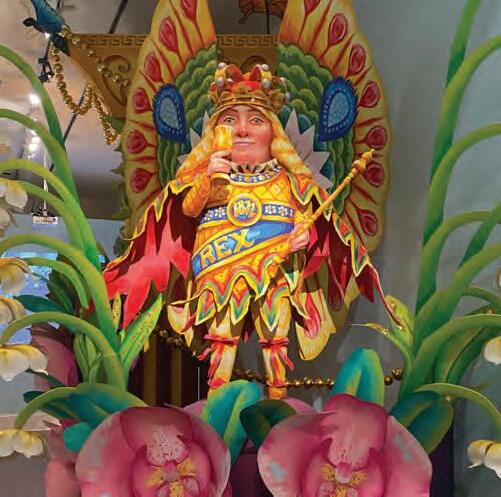


Buddy Guy, the eighty-sixyear-old blues star from Point Coupée Parish, is embarking on his final tour this month. As the eight-time Grammy winner’s road retirement looms, the question arises—who’s going to fill the mighty bluesman’s shoes?
Some rising young stars are staking territory. Christone “Kingfish” Ingram, a popular twenty-three-year-old singer-guitarist from Clarksdale, Mississippi, has already won his first Grammy Award. Jontavious Willis, a twenty-seven-year-old country-blues artist from Greenville, Georgia, earned a Grammy nomination for his second album. And the New Orleans-based Samantha Fish, a thirty-three-year-old singer-guitarist originally from Kansas City, Missouri, keeps moving from strength to strength.
In between Guy’s generation and these new artists, though, is Baton Rouge’s Kenny Neal. A vigorous sixtyfive-year-old, he’s simultaneously enjoying his musical prime while serving as a soulful torchbearer for the blues artists who preceded him. This lineage includes Neal’s late father, Raful Neal, a singer-harmonica player from West Baton Rouge Parish who was a contemporary of Guy, Slim Harpo, Henry Gray, Tabby Thomas, and other Louisiana blues notables.
Even after Neal’s eighteen albums, dozens of awards, international tours, and Grammy nomination for his 2016 album, Bloodline —he’s still hungry. And he possesses the rare combination of knowledge, experience, and artistry necessary to occupy a larger place in the blues world. Neal is “trying to get to the next slot, where Buddy Guy is leaving, if they need somebody in that spot,” he said.
Like his father, Neal is a singer, harmonica player, and songwriter steeped in his native swamp blues. He’s also a master guitarist and a producer; his Brookstown Recording Studio, built in November 2018, and music label Booga Music have produced records for Tito Jackson from the Jackson 5; South Korean-American singer-pianist Hanna PK; the Buffalo, New York-based blues singer Patti Parks; the late, great Lazy Lester; Eddie Levert; Guitar Shorty; Bobby Rush; Jovin Webb; and others.
The first of Raful and Shirley Neal’s ten musical children, Neal was born October 14, 1957 at Charity Hospital in New Orleans. In that pre-I-10 era, Neal’s parents drove their Oldsmobile Rocket 88 from their home in Erwinville to New Orleans, barely reaching the hospital in time for his birth—a “hallway baby,” as he put it. Growing up in rural Erwinville, Neal was naturally drawn to music. “I would crawl up on my dad’s knees when he and James (Johnson) and Rudolph (Richard) (and plenty others) were at the house rehearsing, and stand there and jam to the music,” he said.

Raful gave his precocious oldest son a rich foundation in life and music. “My dad always taught me about respect,” he said, “and treating people the way you want to be treated. Everybody is somebody.”
Neal began performing early, earning tips at six years old during his dad’s Saturday matinée gigs—during which he’d imitate James Brown and dance the Watusi, mashed potato, and Sputnik. “When I danced on the bar, all of the grownups thought I was adorable,” he recalled. “They’d bring me to their table and put a dollar in my pocket. When I left the show, I had four pockets full of money.”
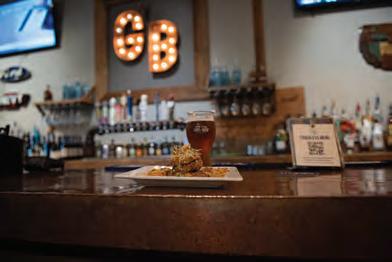
Neal joined his dad’s band at thirteen, replacing a bass player who was chronically late for engagements. “My dad said, ‘Can you play these tunes?’ I said, ‘Yeah.’ ‘Well, grab that bass.’ I kicked off with them, because I had been practicing around the house. When I played that first night, that was it for the old bass player. I had the job.”
Though Neal’s father’s legacy looms large, it was actually Guy who inspired him to start songwriting. “I thought I could do them better.” After six or seven years spent playing in his dad’s band, at age nineteen, Neal left home to play bass in Guy’s Chicago-based band, kickstarting a journeyman era that ultimately convinced him to step from the shadows and become, like Guy and his father, a frontman. “Because the bass wasn’t
gonna get it,” Neal remembered, “I started writing my own songs and learning how to play the guitar, so I could be a band leader. I followed that dream.”

That steppingstone gig lasted until the late seventies, when the blues business took a dive. “The music had died out, so Buddy wasn’t working as much,”

Neal said. Around this time, he was living in Toronto and had started a family. Around 1980, “I went back to Baton Rouge and got my little brothers and took them to Canada.”


Neal’s partnership in the Neal Brothers Blues Band—which included Larry, Ronnie, Noel and Lil’ Ray Neal—lasted


about a year. They scored a house gig at the Isabella Hotel in downtown Toronto, and would frequently bring in musicians like Guy, Sunnyland Slim, Big Mama Thornton, and others to play with the Neal Brothers. “When that first winter hit Canada, they hauled back to Baton Rouge,” Neal recalled. “And I was stuck



with all those publicity photos and posters because I didn’t have the Neal Brothers Band to promote. We looked like the Jackson 5 on that poster. I said, ‘I’ll never do this again. I’m going to go under Kenny Neal for the rest of my life.’ ”
Neal reached a milestone in 1987 when Florida’s King Snake Records released his solo album debut, Kenny Neal: Bio on the Bayou. Chicago’s Alligator Records re-released the album in 1988 with a new title, Big News from Baton Rouge! Over the next six years, he released four more Alligator albums, followed by a succession of recordings on the Telarc, Blind Pig, and Cleopatra labels.
In 2022, the German label Ruf Records issued album number eighteen, Straight from the Heart. It’s Neal’s first solo release from Ruf, first self produced album, and first recording made in Baton Rouge at Brookstown. “On my home turf, with my own musicians,” he said.
Going for downhome authenticity, Neal hired musicians from Baton Rouge, Lafayette, and New Orleans for the Straight from the Heart sessions. His inspiration for the album included his father and other Baton Rouge blues musicians, especially James



Johnson and Rudy Richard, as well as New Orleans rhythm-and-blues stars Fats Domino, Ernie K-Doe and Johnny Adams.
“When I was in here in my studio,” Neal said during an interview held in the control room, “I just relaxed and thought about the music they played when I was a kid. That goes for the whole album.”
Straight from the Heart features an all-star cast of guests. Tito Jackson and Neal’s daughter, Syreeta, sing together for the sizzling “Two Timing.” “Kingfish” Ingram joins Neal for a soaring tribute to B.B.
King, “Mount Up on the Wings of the King.” Baton Rouge pianist Darrell Jefferson adds his gospel touch to “Someone, Somewhere,” a Little Junior Parker song that Jefferson once performed live with Raful Neal. And Rockin’ Dopsie Jr., Dwayne Dopsie, Anthony Dopsie, Big Nate Williams, Lee Allen Zeno, and Kevin Menard douse two songs—“Bon Temps Rouler” and “Louise Ana”—in Zydeco sauce.
Rising from two years of COVID-spawned inactivity, Neal began playing gigs again last spring, one of them being his twenty-eighth appearance at the New Orleans Jazz and Heritage Festival. “We finally got a chance to do it again, and it was beautiful out there.”
In 2022, Neal also appeared at the Blues Music Awards in Memphis, Live After Five in Baton Rouge, and, one of his favorites, the Crescent City Blues and Barbecue Festival. Those gigs were warmups for 2023, which began in January with the Legendary Rhythm & Blues Cruise from Fort Lauderdale, Florida.
“I probably won’t see much of Louisiana in 2023,” the ready-toroll Neal admitted. “It’s going to be like that.” h
kennyneal.netOn a recent Monday afternoon, I found mmyself sitting in a circle, jam-session-style, wwith five emerging Cajun musicians— all of them under twenty-five, all of them women. I’d just asked about their influences, their personal superstars. Growing up immersed in the world of Cajun music, who did they model themselves after?

They answered with the classics, of course—the forebears of what we call Cajun and Creole music: Dennis McGee, Canray Fontenot. There were the exciting, Grammy-nominated bands of today: Lost Bayou Ramblers, Corey Ledet, the late Courtney Granger. Adeline Miller, the fiddler among us, cited Mamou Playboy David Greely as an inspiration. There were the talents who taught these women all they know: Brazos Huval, Blake Miller. And there were the icons within their own families: Amelia Powell shared that she can’t help but be partial to the sound of her grandfather’s band The Balfa Brothers; while Renée Reed indicated she instinctively turns to the accordion songs of her grandfather, Harry Trahan. Julie Babineaux smiled as she responded, “My sister,” looking at Gracie just across the circle.
But when Gracie brought up Bonsoir, Catin, everyone started nodding emphatically, releasing “yes!”s and hums of affirmation. “Oh my God, I remember listening to that shit and being like ‘Ohhh!’ It’s this band of women … I mean Christy Guillory on that freaking accordion! Being able to see that … they’re all these beautiful women just throwing it down.”
“Bad. Ass,” Julie agreed.
“I remember just being, like okay … that’s possible,” Gracie went on. “Like I mean, obviously we’re playing music and having a good time. But all the cool—like on all the big stages—it’s a lot of men. Which is fine. But just to see the women!”
It’s a funny time to find Cajun music as a calling, as a young person in the twenty-first century—even growing up in the heart of Acadiana. American pop culture is so very inescapable now, the mainstream layered over everything, taking precedence in our language and our lifeways. And our music.
Where it survives, the Cajun culture does so in vibrant, glorious bursts—pockets of passion for the heart of this place’s past. You either find it, or you don’t. But then, it’s up to you to engage: to learn the stories,
the language, the songs. In the origin stories of today’s Cajun musicians, there is always a gift, and there is then always a choice.
For Renée Reed, the gift came entwined in her genes. Hers is a heritage dedicated to the spirit of the Cajun prairie: her great uncle was preservationist Revon Reed, who we have to thank for much of what we remember about what it means to be Cajun. Her grandfather was the legendary accordionist Harry Trahan, who taught his craft to Renée’s mother Lisa, L’esprit Cadien’s accordion player; and her father is multi-instrumentalist and renowned fiddle teacher Mitch Reed, from the Grammy-winning band BeauSoleil.
Reed’s childhood was anchored by her parents’ Saturday jam sessions and busy gig schedules. “And I just remember being kind of bored all the time,” she laughed. “They were like, ‘What do you want to be when you grow up?’ And I was like, ‘Not a musician.’”
Reed chose music before she chose Cajun music, falling in love with British folk and at age ten pulling her father’s guitar off the wall, spending hours teaching herself to play the Beatles’ “Yellow Submarine”. Once she could play, to join in on the Cajun jams all around her was inevitable—and today Reed, twenty-four, has cultivated an ethereal musical style all her own, swirling with the influences of Cajun folklore, style, and dialect. Creating something altogether new, sung in a language of old—Reed’s choice to embrace her Cajun identity has resulted in dual degrees in Traditional Music and French from the University of Louisiana-Lafayette and a vocation as an internationally-touring singer-songwriter and local music educator, culminating in a full-length album and companion EP that has attracted the attention of NPR, Pitchfork, Guitar.com, and others.
Similarly born into an established musical legacy, Amelia Powell, twenty-one, said that her earliest memories were of hearing Cajun music. “I remember falling asleep on stage, on like the big dance stand when my parents were playing one Saturday night for a festival,” she said. “Sophie, my little sister, and I would set up a little palette and fall asleep in the back corner of the stage.” Powell’s parents are old-time Appalachian-turned-Cajun fiddler and banjo icon Dirk Powell and Christine Balfa—the youngest daughter of Cajun music legend Dewey Balfa, of the Balfa Brothers—and a Grammy-nominated musician in her own right. When Powell
was a child, her parents both played in the band Balfa Toujours, which translates to “Balfa Forever”.
People have always told Powell of her responsibility to carry on her parents’ legacy. “I get told that very often, you know, that you’ve got to keep it going, you have to do this. Like a sort of obligation,” she said. “Which used to make me not want to.”
She had to make the choice on her own, she said. There were several experiences that ultimately inspired it, but she remembers one specific occasion where she envisioned the future she wanted: “We were at Balfa Week”—the week-long music camps hosted by Louisiana Folk Roots, the nonprofit her mom founded—“at Chicot Park, and I was in one of the bunk beds. And I kept waking up, because I heard my parents and their friends on the porch, jamming, all night. Just yelling and singing and having so much fun, and I just remember being in my bed, can’t sleep. I remember this moment of being like ‘This is really cool … I think I want to do that.’ I could see myself being out there when I was older. I wanted to be on the porch.”
Today, she’s on the porch, and on the stage. A vocalist and guitar player, known to pick up the triangle or the fiddle when called to, Powell has been playing locally and touring internationally with her parents and a collective of other Cajun bands since she was twelve, even sharing the stage on occasion with the likes of Joan Baez and contributing vocals to Rhiannon Giddens’ 2017 album Freedom Highway.
Powell emphasized that she holds her particular gift of Cajun music deep in her soul—“When I play music, I feel connected to my PerPer [Dewey] and to the Balfa Brothers,” she said—but the choice was absolutely hers. “I don’t play Cajun music because I came from it. I don’t just play because my parents played it. It really brings me more joy than anything in the world.”
In recent years, Powell has most often been seen playing with her own band, Amis du Teche, with longtime friend and fiddler, Adeline Miller, and Miller’s brother Robert. Powell and Miller met when they were eight years old, playing music at Bayou Teche Brewing, and have maintained a friendship—enriched in no small part by their shared love of Cajun music—ever since.
Miller, twenty-one, traces her gift back to when she was five years old, and had just moved to Breaux Bridge from Westchester, New York. She didn’t come from a
family of famous musicians, but she did come from a family of dancers.
Shortly after settling into their new home, the family attended a Cajun jam at the local coffee shop. “Normally when you’re dancing,” she said, “you’re not like studying the musicians. Most of the time, you’re studying your partner, or I’d be listening to my dad trying to teach me the steps. But that was the first time I studied the fiddle player.” He was an older man, in a wheelchair, and he gave her the gift. “I didn’t realize how much he would change my life, but he told me, ‘You can’t play sports forever, you can’t do so many things forever. But one thing you can have forever is music.”

In short order, Miller and her dad started taking group fiddle lessons with Reed’s father, Mitch. At his advice, she moved on to become a student of master teacher Brazos Huval. In four months, she passed her dad up. “He was like, ‘You got it, I’ll learn how to play the triangle,’” she laughed.



From there, Miller’s never looked back. She has become a familiar face on the local festival and concert series circuit, making cameos in performances with several of the biggest Cajun bands of the day, and has even performed on stages in Maine and Nova Scotia. This year, she, Robert, and Powell will be the closing act at the annual Faquetaique Courir de Mardi Gras—something she “could have never imagined”.
Then there are the Babineaux sis-

ters—Julie, twenty-two, and Gracie, twenty-four. “Our parents weren’t like ‘Cajun,’” explained Gracie. “They weren’t music fanatics. We listened to Van Morrison, lots of country. Old Mickey Gilley.” At age six, a first-grade teacher was introducing to Gracie pieces of the language her grandfather spoke—numbers, colors. And songs. Then came Hurricane Rita, in 2005.
The Babineaux lost their house in Forked Island, and found themselves temporarily living with relatives. At the time, one of their cousins was learning to play the accordion. “We didn’t have any toys, we didn’t have anything to do.”

“You can only play so much pinball on the computer,” Julie added.
One day, Gracie pointed to the accordion and asked her cousin, “What’s that?” He offered to teach her. “Then Julie was like, ‘What’s she doing?’” Gracie laughed. “‘I want to do that too.’”
Today, Gracie still plays the accordion as well as lead vocals, while Julie’s taken up the bass. The two have been performing as the Babineaux Sisters Band since they were preteens and have released a handful of independently-produced albums with old tributes and original songs alike—frequently taking the stage at major regional festivals including Festival International de Louisiane, Festival Acadiens, and French Quarter Festival.
“It was almost like an accident,” reflected Gracie. Or a gift.


It’s a small world, the Cajun music community. For a time, Reed’s parents played in Balfa Toujours with Powell’s parents. “And both our moms were Magnolia Sisters,” Powell added. “And your grandfather and my grandfather played together,” noted Reed.



“And I took lessons from your daddy,” Gracie said, pointing at Reed. “And so did Julie. “And,” she pointed at Powell, “I learned songs from your mama.”
“And we both took lessons from Brazos,” said Julie, pointing to Miller—“and Amelia did too!”
“And, like, I’ve been knowing all of them—” Reed gestures around to the group as a whole, “—we all went to Kids Camp together.” At this, the conversation erupted into a glitter of memories from their time at the Louisiana Folk Roots summer camp—an extension of Balfa Week’s musical intensives designed for children. Kids Camp started in 2008, with workshops taught by the emerging class of Cajun and Creole musicians of that time: Courtney Granger, Corey Ledet, Chris Segura, and Kristi Guillory—as well as by Powell’s mother Christine Balfa. Reed, Powell, Miller, and the Babineaux sisters were some of the camp’s first students.
Miller said that she started at the camp a few years younger than most other kids, and remembers so clearly the way she looked up to the “big kids” like Gracie and Reed. “We talk about being



inspired by the old men sitting on the porch,” said Powell, “but all of y’all—y’all were so inspiring.”

As they got older, most of them stayed involved with the Kids Camps—work ing as counselors or workshop leaders. “It’s funny, like this past summer, to be sitting with them—you know like Braz and Chad Huval,” said Powell. “Like Braz was teaching me when I was like eight, and to be on the other side of it now and be teaching … it’s cool. All of a sudden, you’re in the same category or considered peers with these people we all grew up watching.”
There’s a pressure that comes with that, said Gracie. “When we were all starting to play music, you remember the older people who come up to you, who give you the time of day. And so now we’re older, there’s these younger people coming in and it’s like ‘Crap, okay now I have to make sure that I do that, too. I want those people to continue playing music. What can we do to make sure they feel encouraged and safe?”
Passing down the gift is a common aspiration between all five of these women, who have each engaged in teaching on some level. Powell hopes to someday spend her time performing and teaching music workshops across the country. Julie, with her degree from ULL’s Traditional Music Program, is actively working on getting her teaching certification—“I want to teach other young people to feel the way that
I do about their culture.” And Reed and Miller are both currently teaching music classes at the Music Academy of Acadiana, where one of Miller’s students recently told her the lessons were showing her how to be “a part of something that was a part of her.”

One of the biggest challenges of committing to Cajun music is an essentially practical one, simultaneously spiritual as an act of cultural preservation: learning the language. All five women grew up in families where someone still spoke French, a sort of secret code shared only among the few.
For Gracie and Julie, it was their maternal grandfather, “but he never spoke it
with us, or around us, ever.” Part of that last generation of native French speakers in Louisiana who were told their language was inferior to English—he carried the collective shame that halted the passing down of the Cajun tongue.
“Because it was so intentionally killed off, it feels even more important for us to learn the way that they spoke,” said Powell.
Gracie said that once she had started playing the accordion, her parents would bring her and Julie to local jams taking place around their home in Cow Island. “I remember I had an old man at one of the jams that told me, ‘If you’re gonna play a song, you better know how to sing the words.’”
Gracie took it to heart, meticulously pausing and rewinding her CDs of Cajun music, writing out the words phonetically, until she could imitate the sounds perfectly. “But eventually, you want to know what you’re singing.”
At age fifteen, she traveled to Nova Scotia to attend the Université SainteAnne Immersion Program in Church Point, Canada—a Francophone pilgrimage taken by a growing cadre of today’s Cajun culture bearers and musicians, including Miller and Reed. The five-week immersion course put them on the fast track, but each of them still hesitates to call themselves fluent. “I came back and have been trying to keep it up,” said Gracie. “But it can be hard.”
Even Reed, who in addition to her experience at Sainte-Anne’s, has been part of French immersion in schools, and majored in French at ULL, said it’s an ongoing process. “I’m getting there,” she said. “But I think it’s so important because the language brings so much meaning to the music, and to the stories, and to the jokes, and the food. It’s just so important. It like holds it all together.”
Miller agreed, speaking to the way learning the language motivated her to improve her singing. “I always loved the melodies and the fiddle, but learning French and diving into the stories told, usually in a place that is so familiar. It made me love the lyrics so much more.”
Julie, who is planning on attending Sainte Anne’s in the coming summer, has
usually left the singing to her sister, and “hid behind her bass”. These days, though, she is taking more intentional steps to improve her grasp of the language—inspired by her experience as a host alongside T’Monde guitarist Megan Constantin for the KRVS radio show “Encore,” which plays music pulled from ULL’s Center for Louisiana Studies Cajun and Creole Music archives. “That was just the most incredible time of my life,” she said. “I learned that singing in French doesn’t have to be perfect. Listening to those old recordings, they’re not perfect. So, there’s no pressure. You just sing it. You tell the story. And you just keep it going.” One of her favorite parts of those old recordings, she said, are listening to the musicians talk before and after their performance. “They’re just hanging out,” she said.
“Just like we do!” said Powell.
“It’s true,” said Gracie, “hearing the language and knowing what they are actually saying in those moments, it adds another layer.”
Reed and Powell both said that they grew up in families where French was spoken more often than in most households of the early twenty-first century. “Both of my grandparents, their first language is French,” said Reed. “So it was just kind of all over the place. But storytelling is a big thing in my family, especially on my dad’s side, and a lot of those stories are told in French. So I don’t know, I kind of grew up speaking Franglish.”
Powell said that her mother intentionally tried to introduce her to French while she was first learning English, “but then you don’t speak it every day, and you go to school and nobody’s speaking French at school, so I lost a little bit of it.” She’s compensated by using language-learning apps like Duolingo and Babbel, and hopes to attend Sainte Anne’s someday too. “But I really really want to speak Cajun French,” she said. Listening to old interviews of her PerPer Dewey, she’s marveled at the particular beauty of the Cajun dialect.
At this, Reed interjected: “One of the beautiful things about it is how funny it can be. It’s the way that it sounds, like this sharp …”
“The word for it is ‘brut’” said Powell. Everyone laughed, each inserting their own exaggerated “Brut” into the circle. “See?” said Reed. “Even the word ‘brut’ just makes me laugh.”
In her effort to learn the particularities of Cajun French, Powell has turned to her closest resource, her
mom. “We’ll have nights where my sister and I go to her house and cook dinner together,” she said. “She’s like teaching us how to make a rice and gravy, and we eat dinner, and we speak French.”
Over the past five to ten years, as they have transitioned into the contemporary Cajun music scene as young adults, this class of musicians has at times had to contend with their own novelty as young women in
 Chana Heintz, MD Pediatrician
Chana Heintz, MD Pediatrician


Cajun music—to show people they are not just cutesy girls playing folksongs, but serious musicians and culture bearers in their own right.
“I have this one memory of when Adeline really inspired me,” said Powell. “We were playing with some grand culotte band, some hot shot—you know—men. And good people, good musicians, friends who I look up to. But we must have been like seventeen, and we had just gone to hear them, and got called up on stage. And everybody was like ‘Oh I can’t believe these two beautiful women on stage, oh these beautiful women, these young girls playing music. That’s so awesome, wow.’ It was just, in between every song, the chatter onstage was that. And finally Adeline just looked over at me, this man was standing between us, and she looked behind him at me and was like—and Adeline does not curse— ‘How about some badass, talented musicians?’ And I was like ‘Okay I’m done with this bullshit.’ I was just like, done with being a cute pretty girl whose gonna, like, play and sing for you. I’m a musician. That’s it.”
When I ask them what distinguishes their generation of musicians from those that have preceded them, they each have their own answers—but all speak to a shouldering of the responsibility to ensure this music tradition lives on, which ironically might be best achieved, they said, by exploring new ways of expressing it.
“I’m really interested in using the language in different ways,” said Reed. “Taking the Cajun dialect of French, Cajun/Creole and putting it into original songs, that don’t necessarily have to be that traditional in style.”
Julie agreed, saying that she originally decided to pick up the bass because she wanted to play rock ‘n’ roll and funk. “I wanted to incorporate that, but still keep who I was, culturally … and in a way, we get other listeners to come in, and they think ‘Oh my God that’s such a cool song, what are they saying?’”
A great example of a band that does this well, they said, is Bonsoir, Catin. “They have a bunch of really cool arrangements,” said Powell, “like really different stuff that’s like ‘Woah I didn’t know Cajun music could sound that way,’—just evolving the tradition. But they can also just throw down a two-step, nothing special, nothing fancy. But God, you can’t help but want to dance.”
—AMELIA POWELLThis is important, because to authentically push the tradition forward, you have to understand where it came from, the songs that define what we know to be “Cajun music”. “Going back and listening to the old stuff,” said Julie, referring in particular to some of the earliest field recordings made by ethnomusicologist Alan Lomax in the 1930s, “people are like, ‘What is he doing? That sounds horrible.’ But if you really listen to it, it’s incredible stuff. It’s like the rawest form of Cajun music that you could ever listen to.”
For years, Reed also worked in the Center for Louisiana Studies archives, spending hours with headphones on just saying to her coworker, “Oh my God, listen to this.” “You just don’t hear stuff like that on the radio anymore,” she said. “Listening to it, it’s like ‘Where did this melody come from? Is that from Canada? Or Ireland? It’s just really cool, making the connections, finding out the history of the music, going on these deep dives.’”
For Powell, some of Cajun music’s touchstone recordings are of her grandfather and his brothers. “Those old fiddle tunes? The way my PerPer would play them … That—I love that sound,” she said.
“And Rodney and Dewey’s voices together?” gushed Reed.
“It’s so good!” said Powell. “It just, it like hurts it’s so good.”

In 2019, Bonsoir, Catin opened Festivals Acadiens et Créoles in Lafayette—which was curated around the theme of “The Role of Women in Cajun and Creole Music”. As special guests, Miller and Powell joined the performance on fiddle and guitar, respectively, and as lead vocalists.
Recalling that performance, Miller said that she got on stage with a rare wave of performance anxiety. “I was so nervous … the people I was getting on stage with. They wrote these songs, like if I messed up, they were all gonna know. They play this song every day, you know? So, I’m getting ready to play my first note, and I look over at Amelia. And it was just like this super deep stare, and I was just like ‘No’. Like, no. This is fine. And that was probably the best performance I had been a part of, with these other women that are just so influential in my life, that I grew up obsessing over, and I was always up against the stage trying to study them. I was getting to be a part of something that’s so much bigger than me, and I was doing it with my best friend.” h
“WE TALK ABOUT BEING INSPIRED BY THE OLD MEN SITTING ON THE PORCH, BUT ALL OF Y’ALL—Y’ALL WERE SO INSPIRING.”
As soon as it was light enough to see on a recent November morning, I pulled into a pasture near Arnaudville, where my friend Yvonne Olivier lives in a nineteenth century home flanked by cypress barns. A group of friends and neighbors were already chatting, having coffee, positioning their over-sized cast iron pots onto propane burners.
Yvonne and I were hosting a boucherie de quartier—the neighborhood slaughtering of a pig. The first
time we did this, in 2019, I slaughtered two pigs that I raised myself. After I shot each one with a .22, it took under an hour for the group of us to capture the blood for later use, remove the hair and internal organs, and carve up the animals. This year, we took the less-traditional-but-still-effective route of purchasing an already-butchered pig from a friend. I doled out the specific cuts of meat to the group, who had positioned themselves in a circle of five cooking stations.
Our assigned dishes were a collection of those traditionally made at boucheries. The heart, kidneys, and parts of the liver were mixed with tenderloin in a stew called fraisseurs. The backbone was slow-cooked until the marrow melted out. Cuts of skin, fat, and meat were fried to make gratons. There was boudin, a mixture of rice, liver, meat, and seasonings stuffed in casing. We also had jambalaya, fried pork chops, pork stew, smoked ribs, and bacon.
At other boucheries, you might also find hog’s head cheese—cooking the pig’s head and mixing it with onions, bell peppers, and spices into a gelatinous mass, often served on crackers. In addition to regular boudin, folks often make blood boudin, as well as sausage— the intestines are removed, cleaned, and then packed. Ponce, a sort of sausage that has been stuffed in the pig’s stomach, is also common.

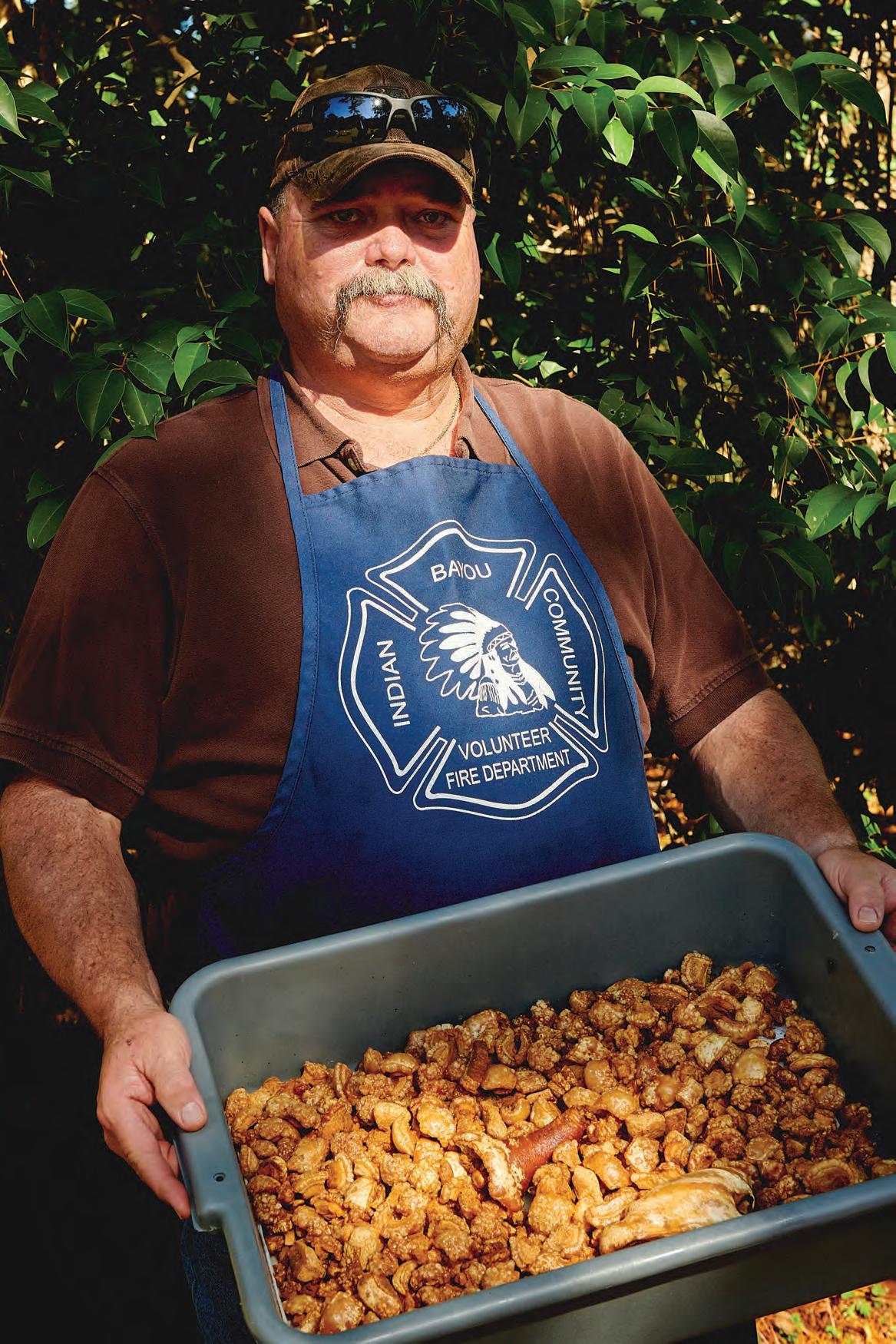
As the day wore on and guests continued to arrive, folks walked back and forth visiting with their neighbors while we cooks stewed and grilled and fried. Musicians sat in the middle of our circle and with their accordions, fiddles, triangles, and guitars, they played traditional Louisiana songs. When a dish was ready, a call went out and everyone lined up to taste.
Pig preservation techniques originated thousands of years ago in Europe. According to Bruce Aidell in Complete Book of Pork, “The annual community pig slaughter became a tradition in many communities and was a cause for celebration. There were Schlachtfests in Germany, boucheries in France, matanzas in Spain, and the festa del porco in Italy. One large, well-fed pig could keep a large family, or sometimes a small village, wellfed throughout the winter.” Due to Louisiana’s Francophone origins, the name of our practice remains in French. Yet, there is actually no direct line from France’s particular methods of meat preservation to Louisiana’s tradition. Our boucherie certainly includes French elements, such as blood sausage, and hog’s head cheese. But the tradition has also been touched by the hands of many groups of Indigenous peoples, West Africans like the Bambara and Wolof peoples, Creoles of the Spanish Caribbean, and Germans.
Chase Cormier, a PhD candidate at the University of Louisiana at Lafayette who is finishing his dissertation, “The Boucherie: Nourishing Francophone Culture in Louisiana,” told me Native Louisianans like the Choctaw used smoke to preserve sausage and tasso, while they cooked bear skin in its own fat, similarly to the way pork cracklin’s are made at a boucherie. Techniques like braising and slow cooking can be traced back to various West African culinary traditions, introduced with rice agriculture to Louisiana by enslaved people brought to the region in the eighteenth century. Germans who settled along the Mississippi River in the 1720s contributed andouille made in a smokehouse, or la boucanière. And the traditions of Spanish Caribbean Louisianans brought in hot peppers. “All of these different groups valued sustainability at a time when that was incredibly important,” said Cormier. “The boucherie is a mix of these different cultural elements.”



Louisiana boucheries before the Civil War and in the colonial period continued the ancient, communal aspect of the tradition. This is why, in Louisiana French, the tradition garnered the names boucherie de bloque, boucherie de quartier or boucherie de société —all referring to the communal aspect of the event. But, at that time, the event lacked the festive flair of boucheries today. “These boucheries were strictly about survival,” Cormier said of early Louisiana boucheries. “People were sharing and maximizing what they could get out of an animal.”


Winter was the ideal time to slaughter a pig that had spent the summer and fall fattening up. Cormier said winter also aided in storage; people would stash food on the north side of the house, made cooler by winter winds and increased shade during that time of year, or in cisterns or wells. Only dishes that would spoil fast were eaten that day—a stew, for example. Everything else was smoked, heavily salted, or stored in the pig’s fat in jars. Even with these preservation methods, in Louisiana’s mild climate the meat would only last a few weeks.
A slaughtered hog, which often yielded hundreds of pounds of meat and fat that no one family could consume, was shared among neighbors so it wouldn’t go to waste. After the meat ran out, a neighbor dispatched their pig.
Another crucial aspect of boucheries at this time was using tallow to make candles and soap—ensuring the community had adequate lighting and a way to stay clean, which promoted good health.


With the rise of certain modern conveniences, like storage areas stocked with blocks of ice and eventually refrigerators, boucheries from the 1890s to the 1950s allowed for less solemnity around the tradition, which began to function more as a festive event— though it remained grounded in the spirit of sustenance. Cormier called this style “sharecropping-era boucheries”.

In a recent conversation with my grandmother, Betty Olivier, who grew up in Pécanière in the ‘30s and ‘40s, she explained, “Tout le monde alentour venait pour la boucherie. Quand eux-autres partaient, ils avaient leur viande, leur boudin, leurs gratons. Ça c’était pour eux-autres. C’était séparé. Là une autre semaine, quelqu’un d’autre faisait une boucherie.” [Everyone from around here came for the boucherie. When they left, they had their meat, their boudin, their cracklin’s. That was for them and it was separated. Then another week, someone else had a boucherie.]

She told me that the women often made the boudin while the men cooked gravies,
smoked meat, and made hog’s head cheese. While food was being preserved, it was also consumed throughout the day, enjoyed along with the camaraderie and an element of celebration provided by the community’s musicians.

At this point in its history, the Louisiana boucherie was firmly established as a gracious collaboration that warranted selflessness, trust, and coordination within communities—embodying Wendell Berry’s vision described in the 1968 essay “The Loss of the Future”: “A community is the mental and spiritual condition of knowing that the place is shared and that the people who share the place define and limit the possibilities of each other’s lives. It is the knowledge that people have of each other, their concern for each other, their trust in each other, the freedom with which they come and go among themselves.” When Berry wrote that essay, those virtues had been fading from the Louisiana landscape due to Americanization, industrialization, and the modernity of an increasingly globalized world.

Yvonne and I didn’t host our boucherie out of necessity, of course, but as a gesture towards sustaining the cultural traditions of our home. This perspective embodies the contemporary boucherie—a designated day for people to come together, share food, play music, and intentionally celebrate their culture.
In The Cajuns: Americanization of a People, Shane K. Bernard considers the modern continuation of these traditions in terms of sociologist Herbert J. Gans’s concept of “symbolic ethnicity”—which “permits minorities to feel ethnic by participating in traditional holidays and festivals, by consuming traditional cuisine, and by listening to traditional music, among other activities—none of which require the burden of practicing folkways on a daily basis.” Instead of an integrated way of life, Gans observed, “Ethnicity has become a leisure-time pursuit.”
No longer a necessary venture for community survival, boucheries provide a space for symbolic practices of tradition for twenty-first century Louisianans, allowing someone to express their Cajunness or Creoleness for one day with the option to return to more mainstream values the next. The event acts as a tool to help Louisianans hold on to a unique identity that has been central to their cultural fabric.
This makes the boucherie an imperfect act of cultural preservation. Though the tradition keeps intact some cultural values—such as the ritual of slaughtering a pig, the consumption of regional dishes, playing and dancing to Cajun or Zydeco music—contemporary boucheries have also taken on their own, new meanings.
Take Jeffrey Burge and the Pa Ta Sa Cooking Krewe, for example. Burge, from Eunice, and a group of around thirty friends host boucheries for festivals, cook-offs, and other events. With the help of sponsors, they purchase a pig, slaughter it, and then sell various dishes to festival-goers. In turn, Burge and his group donate the proceeds to a charity or other worthy causes. This year, Burge and his group will lead Eunice’s Old Time Boucherie at Lakeview Park & Beach on Lundi Gras. Other groups have popped up with similar missions. Toby Rodriguez, from Grand Coteau, traveled around the state and country to host pay-for-entry
boucheries as a means of educating people about Louisiana traditions. Other examples are Vermilionville’s La Boucherie Merci, John Folse’s Fête des Bouchers, and St. Martinville’s La Grande Boucherie des Cajuns.



In this way, the modern boucherie can sometimes seem more a performance than a continuation of our ancestors’ traditions, more re-enactment than active participation in a culture. Regardless, these events hold value for their ability to bring people together in the spirit of the old tradition.
By inviting Yvonne’s and my neighbors and family to our boucherie, I thought that for at least a day we might take one step closer to invoking Berry’s depiction of community. The optimist in me believed that a few visitors would walk away with a newfound appreciation for the collective, a lost way of living in this country’s capitalist, independent-minded society—a memory we can’t stop clinging to. h

In the summer of 1966, when Elvis Presley went into a Nashville studio to record his ninth studio album, his career was waning. His 1965 album Elvis for Everyone!—a hodge-podge of abandoned singles from the course of his career—was hselling poorly. It had been years since he made a proper album, opting instead to put out mediocre soundtracks for mediocre films he starred in. And the public had not taken to those, either. Meanwhile, Bob Dylan had redefined popular music, the Beatles had gotten hot, and Presley had turned thirty-one, ancient for a rock star. Facing a professional crossroads, Presley—whose sex appeal and robust vocals had defined rock music a decade earlier—made the curious decision to record, of all things, a batch of gospel songs.
Released in early 1967, How Great Thou Art sold more than three-quarters of a million units and won the Grammy for Best Sacred Performance—Presley’s first. The album’s success should not have come as a surprise. Gospel had always been Presley’s favorite music to sing, and for good reason: his first public performances occurred inside his mother’s church in Tupelo, and he carried memories of singing hymns with his father. In reconnecting with the music of his Mississippi childhood, Presley not only gave his sagging career a boost, but reignited a passion for music in himself and in his fans.

What has always gone unnoticed is that Presley gave a subtle, perhaps even inadvertent, nod to his home state when choosing the songs that would make up How Great Thou Art. Of the thirteen gospel songs that make up the album, two were written by Mississippi natives. They were both Christian songwriters from south Mississippi who each had one song recorded by Elvis Presley in RCA Studio B in Nashville on May 27, 1966. The similarities end there, though. In almost every other imaginable way, their little-known stories are polar opposites, as are the stories of the songs they wrote that came to anchor one of the twentieth century's greatest gospel albums.
One morning in 1961, a seventeen-year-old high school senior named Mylon LeFevre sat in his Fresno, California dorm room thinking about the Bible verse John 15:5, which states, “Whoever remains in me and I in him will bear much fruit, because without me you can do nothing.” LeFevre later said that while pondering the verse, a melody “bubbled up” from inside him, and he wrote the lyrics to a song. He called it “Without Him.” It was the first song he ever wrote.
Born in the U.S. Naval Base Hospital on the Mississippi Gulf Coast in 1944, LeFevre was the son of Urias and Eva Mae LeFevre, both of whom were part of the legendary singing LeFevres, a family musical act that would be inducted into the Gospel Hall of Fame in 1998. After graduating from high school, Mylon LeFevre joined the U.S. Army. In 1962, he hitchhiked from his military base in Columbia, South Carolina to Memphis, Tennessee to sing at the National Quartet Convention with his parents. That night, in Ellis Auditorium, while still wearing his military uniform, LeFevre sang “Without Him.” One of the spectators was Elvis Presley, an Army veteran himself.
Five years later, when Presley's version of “Without Him” closed side one of How Great Thou Art, LeFevre received a royalty check for $90,000—the equivalent of more than $800,000 today. The song went on to appear on more than 120 other albums. That type of money and success led to trouble for LeFevre. “I made so many wrong choices,” he said. “I let music become an idol in my life.”
Though he never quit the entertainment business—playing rock music and touring with Pink Floyd, The Who, and Black Sabbath—LeFevre spent much of the 1970s mired in drug addiction before getting sober in 1980. “At thirty-five,” he said, “I had to start over and ask Him to forgive me.” For a while he worked as a janitor at a Christian church in Georgia before eventually reentering the music business as a Christian artist.
Today, LeFevre is a 78-year-old minister based in Texas.
The other song on How Great Thou Art penned by a south Mississippi native has a story that is much more mysterious.

J.B. Coats was born in the community of Gitano in Jones County in 1901. A local music teacher named Val Sumrall taught him to read shape notes, and, by the age of fourteen, Coats was leading singing schools—rural gatherings led by instructors contracted to teach the basics of music and singing, usually over the course of ten days. Coats taught singing schools on the Gulf Coast and in the Mississippi Delta for the rest of his life.
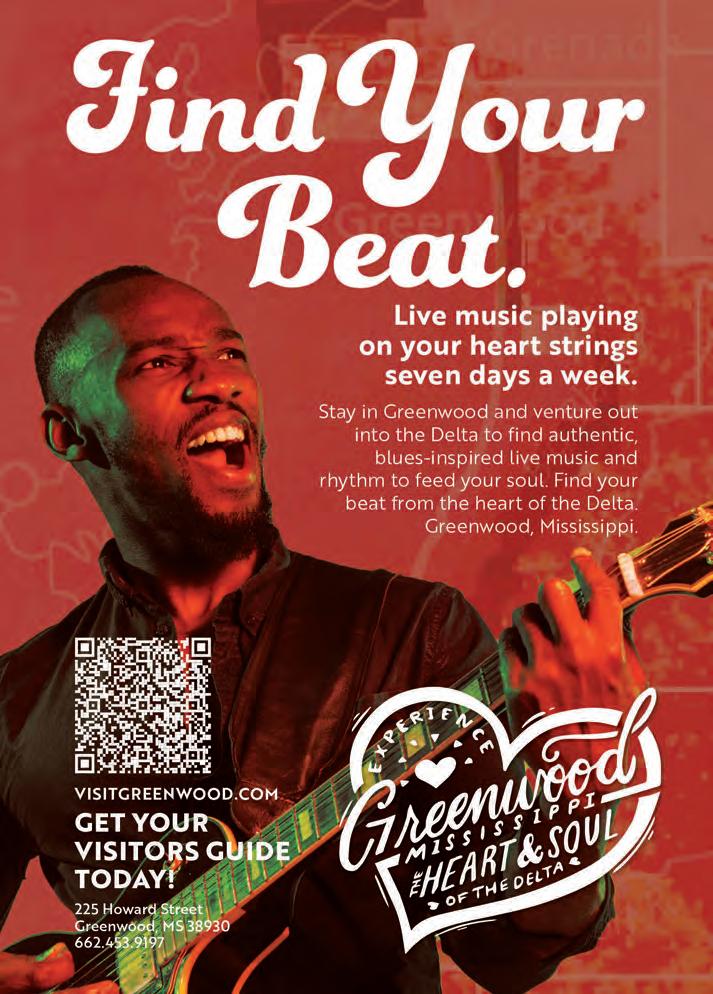
During the day he worked as an educator in a public school near Gitano, teaching three grades. On the side, Coats, a deeply religious man, composed hymns, eventually compiling more than 150, each one of which he believed God delivered directly to him.

In 1940, Coats (or perhaps Stamps-Baxter Music and Printing Company, the pub lishing entity he wrote for) filed a copyright for a composition he wrote which con sisted of three quatrains that each ended with the refrain, “Where could I go but to the Lord?” Coats named the song “Where Could I Go?” It has since become a gospel staple.
Almost a decade ago, a man named Austin Bhebe claimed in a blog post that Coats wrote the song after a dying neighbor, who when asked where he would spend eternity, replied to Coats: “Where could I go but to the Lord?” While it is an absorbing story, the dying man’s name was reportedly Joe Keyes, and an exhaustive search for a “Joe Keyes” or “Joseph Keyes,” who died in Jones County during Coats’s lifetime turned up problems. Someone named Johnie Keyes died in 1934, but the spelling of the first name suggests it may have been a woman and, besides, there is no reason to believe “Johnie” would have gone by “Joe.” Someone actually named Joe Keyes died in 1942, but that was two years after a copyright was filed for “Where Could I Go?” Bhebe, who lives in Nairobi, Kenya, did not respond to a message, and his post did not state where he got his information.

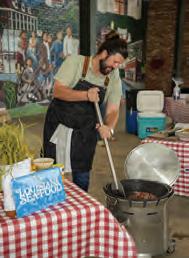
Still, there are reasons to believe his story might be true. Edsel Coats, one of J.B. Coats’s sons, said his father “received inspiration among the people in ‘the old country church atmosphere.’” Coats being stirred to write the hymn after a touching bedside exchange with a dying man would certainly fall into that category. A more intriguing reason to believe Bhebe is that in his blog post, he claimed that Coats actually wrote the hymn “some years” after Keyes’s remark, when he was “away from home teaching a singing school.” This aligns perfectly with a story told by a seventy-four-year-old man who lives on the other side of the world from Kenya.
Wayne Bush, of Washington Parish, Louisiana, claims that Coats composed the song on the grounds of Isabel Baptist Church in the Louisiana community of Isabel. According to Bush, several women a generation older than he said the church hired Coats to conduct a singing school and, during a lunch break, while relaxing beside an artesian well in the shade of an oak tree, he scribbled the lyrics on the side of his lunch sack. In the official Isabel Baptist Church meeting minutes, Bush found a note proving Coats was indeed hired to teach a singing school. But that was in 1953, thirteen years after the copyright was filed. Of course, the church could have hired Coats multiple times, including in the 1930s. Still, where verified truth is concerned, the circumstances surrounding the writing of “Where Could I Go?” remain as elusive as the inspiration.
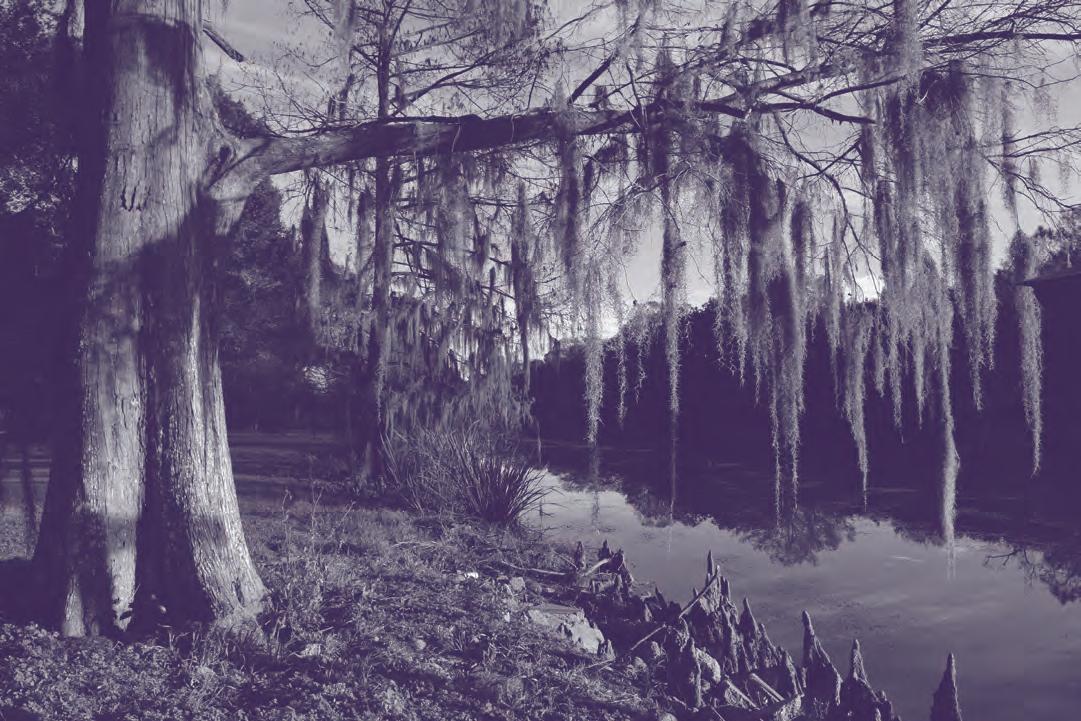
Several popular versions of “Where Could I Go?” were recorded in the 1940s and ’50s, including one by the Harmonizing Four, a group Presley is known to have liked. The song most likely ended up on the second side of How Great Thou Art because Presley remembered singing it with his father during his childhood.
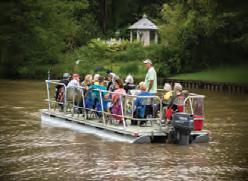
Coats never heard Presley’s version. He died in 1961, six years before the release of How Great Thou Art, and is buried in the tiny Coats family cemetery in Gitano beside his wife, Alice. Lyrics from his most famous song are chiseled into his tombstone, but a mistake appears to have been made.
The inscription is a quatrain that begins with the first two lines of the second verse, then presents the third line of the third verse, before closing with the refrain.
Neighbors are kind, I love them ev’ry one, We get along in sweet accord; Yet when I face the chilling hand of death, Where could I go but to the Lord?
There is temptation to view this mix up as egregious, especially when considering that Coats is said to have viewed his lyrics as poetry, always taking great care in their composition. But it is doubtful that a simple man from a rural community who lived the quiet life of a teacher and wrote Christian hymns in his spare time would have cared for very long. So, no matter. h
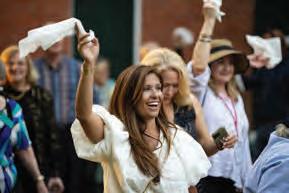
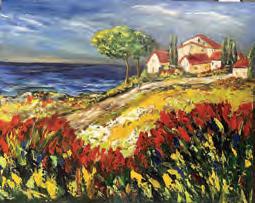
Aduck hunter rises before the first light of day to don camouflage and venture out into the swamp, loyal dog at his heels. Tears and river water stream down the face of a newly “reborn” Southern Baptist. A jazz band leads a family second line from the cemetery, transitioning from dirges to “When the Saints Go Marching In”—a celebration of a life well-lived. These are just a small cross-section of the rituals that have underscored life in the South for more than a century—the rituals that connect us to the land, to each other, and to those who came before us.
Louisiana Public Broadcasting’s newest docuseries,


Ritual, sets out to explore, honor, and contextualize traditions such as these. “What we hope to achieve with the show is a historic understanding of how rituals function in terms of mechanisms of survival, resistance, and joy—culturally,” explained Ritual’ Co-Producer Avery White. The majority of the episodes are focused on the Southern African American experience, meaning that historic issues like slavery, white supremacy, and climate change are often at the forefront of the narration, providing important context for the traditions that emerged because of—or despite—these oppressive systems.

“These rituals really emerged as these indications of human resilience,” said White. “And it’s this beautiful

diamond that comes from suffering, from pain, from oppression. Humans have always managed to have these extraordinary rituals. And those rituals really constitute our existence—[they] keep us holding hands with our ancestors, [they] help us have a context for current society.”
Ritual will premiere on PBS’s “Voices” YouTube Channel, which specializes in short documentary-style content. The first episode, focused on Black burial rights, will premiere on February 14, with a new tento-fifteen-minute episode to be released each month for the duration of the eight-episode series. Other historic rituals the series will explore include the connections be-


tween river baptisms and rock ’n’ roll music, the Haitian Independence Day/New Year’s Day soup joumou, traditions around honoring the dead, and hunting and decoy carving.

To illustrate such vivid traditions, the production team is expending considerable time and resources to gather and include a plethora of “really killer archival footage,” and in general maintain an attentiveness to making the show artful, beautiful, vibrant, and poetic—much like the traditions it presents. “These episodes are intended to be like love poems,” White explained. “They’re really, you know, offerings of admiration towards Southern culture, and the complexity of how culture functions in history.”
Tarriona “Tank” Ball, frontwoman of the Grammy-nominated, New Orleans-based band Tank and the Bangas and a culture bearer in her own right, will host the series. Before becoming a spoken-word poet and now musician, Ball was raised in the Baptist church, coming from a family “stacked with pastors”. The experience meant so much to her that at one point, she wanted to become a pastor herself. “So for her, ritual is a very personal subject,” said White. “It’s evolved from the very ritual-oriented religious experience that she had, into now performing musically for the whole world.”
Besides that deep personal connection, White describes Ball’s presence as host as “wildly magical and

fun”—which is ideal, considering Ritual is part of a larger shift at PBS towards connecting with younger and more diverse audiences. “I think that’s what’s so exciting about this project is that it’s rooted in a sense of newguard storytelling, and perhaps a new face to come for PBS at large,” White said, citing conversations she and Ritual’ producer Emma Reid are having about the future of the network, and its place in the ever-evolving world of entertainment. “We hope it’s going to start looking more like this kind of programming, which is hip, inclusive, really thoughtful, beautiful. And PBS has always had really thoughtful programming—you know, things like Sesame Street, which was incredibly inclusive and groundbreaking,” White said. “But we hope to bring a whole new level of artfulness and relevance that will kind of rock the world in terms of, you know, show-stopping content.”


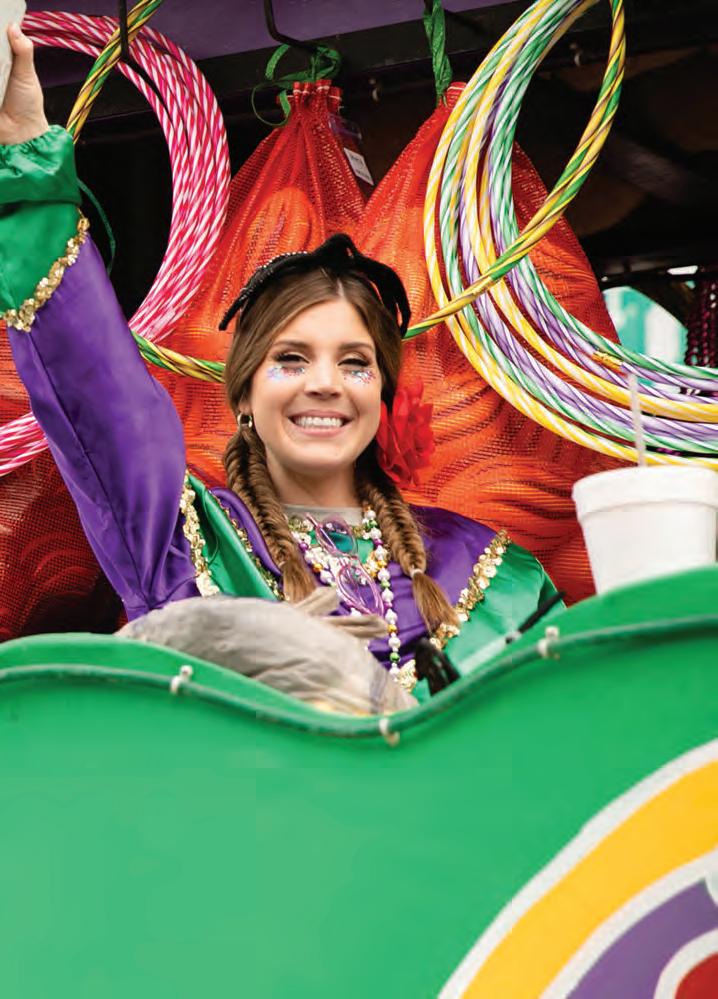
Reid emphasized that particularly in our ultra-digitized era, young people tend to be more disconnected from their communities and traditions than past generations were—and Ritual aims to provide a means of reforging those connections, while hopefully bringing Millennial and Generation Z audiences into the fold of those who watch and appreciate PBS. “Younger people are more and more losing connection to, you know, religion, rituals, the sacred, this community,” Reid said. “And they’re kind of wanting to reconnect with their past, and as we’re becoming more isolated, to learn about these rituals is kind of a way to reconnect— which I think a lot of young people are looking for right now.”
“We’re losing this sense of community, and of orientation within our communities,” White added. “And these rituals steady us. They ground us in our community and in our realities, and they give us joy.”
Ritual is funded in part by a grant from the Corporation for Public Broadcasting, which established new Regional Digital Centers of Innovation at PBS, designed with the intention of creating new content focused on uplifting BIPOC (Black, Indigenous, and people of color) voices, a responsibility Reid and White do not take lightly. “Every step of the way, we’re held accountable to that,” said White. Whether that means hiring Blackowned catering companies or Black hair and makeup artists; creating significant space for BIPOC voices in each episode; or having community members do sensitivity reads on scripts before filming to prevent blind spots—Reid, White, and the whole production team, from those on set in Louisiana to those in the PBS offices in Washington D.C., are committed to “walking the walk” when it comes to supporting the communities the series celebrates. “We have people who are part of that community who make sure the story is ethically told, and the facts are straight,” White said. “I’m very proud of that part of our production.”
These efforts are also part of ensuring that this addition to the historic register is a complete and accurate one. “This show is about adding a page to the history books for the South,” White said. “There are some real deep misconceptions about the South that I’ve observed as a Southerner in other parts of the country— that perhaps we’re not as sophisticated, and we’re not as advanced in our culture. And I think that a big part of what’s cool about this project is that we’re like, ‘No, look how incredibly complicated and extraordinary and artful and diverse our cultures are in the South, and the power that emanates from Southern culture today.’” h
Episode 1 of Ritual will premiere on PBS’s “Voices” YouTube Channel on February 14 @pbsvoices.
It was late autumn. Mardi Gras Day in New Orleans was fast approaching. And Big Chief Lil’ Charles Taylor was focused on feathers. hPlumes in particular. He had been working for months on the outfit he planned to debut in 2018. His intricate beadwork was on track and almost finished. Sequins were applied. And the fabric that would be sewn into the underlying ensemble was purchased. However, Chief Taylor had yet to acquire some final key materials, including edge trim, called “marabou,” made of lengths of downy feathers dyed in various colors; the yards of ribbon needed for the rosettes and other adornments; and most importantly, the feathers and plumes for the garment ’ s “crown.”
He had always ordered the plumes for his crown from a company in New York City. But the price of dyed ostrich plumes had almost doubled. A few of his friends—myself included—brainstormed and reached out to his circle of admirers. And, with community support, Chief was able to purchase feathers and plumes in time to finish sewing and debut his art on Mardi Gras Day.

The Black Masking “Mardi Gras” Indians of New Orleans are a photogenic cultural tradition. Many of us may have seen images of New Orleans ’s Black Masking Indian “tribes” in the streets at dawn on Mardi Gras morning, or parading and dance battling on St Joseph’s night in March, or marching during one of the uptown, downtown, or Westbank “Super Sundays” during which tribes strut their costumes at family-friendly daytime events. But few who aren’t part of the community have witnessed the intricacies of how these amazing “suits” (not “costumes”) are created by local artisanal talents.
I met Big Chief Lil’ Charles Taylor soon after I relocated to New Orleans from Boston to work at Tulane University in 2015. Attending a musical event at Buffa’s Bar and Restaurant, I was mesmerized as he performed with a quartet of traditional New Orleans players as a guest artist, singing a repertoire of Black Masking Indian chants to accompany some of their melodies. During the mid-performance break I found him outside, contemplatively smoking a cigarette. Chief Taylor was kind enough to answer my newbie questions about his songs and his tradition; and even invited me to his home to see his next suit in progress.
Chief Taylor lives in the Musicians’ Village in the Upper Ninth Ward. Together with New Orleans Area Habitat for Humanity, celebrities like Harry Connick, Jr. and Branford Marsalis helped envision and fund this subsidized housing option for qualifying New Orleans culture bearers after Hurricane Katrina. Taylor teaches hand-beading and sewing classes to children at the nearby Ellis Marsalis Center for Music.

Though traditional performers like Chief Taylor have long been known as “Mardi Gras Indians” because of the Native American-inspired “suits” debuted each year on Mardi Gras Day, today a number of those involved in the tradition prefer the term Black Indians.” There are at least three dozen active tribes” in the city, and most are made up of extended families or organized by

Black Indians explain that their masking tradition is an homage to the Native Americans of Louisiana who helped their ancestors escape enslavement, taking them in and making them part of Native communities. Many also claim family lineages that include a Choctaw or Houma or Tunica-Biloxi great-grandmother or other relative—including Chief Taylor, who says he has Cherokee heritage on his mother’s side.
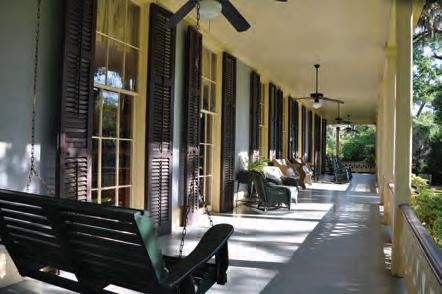

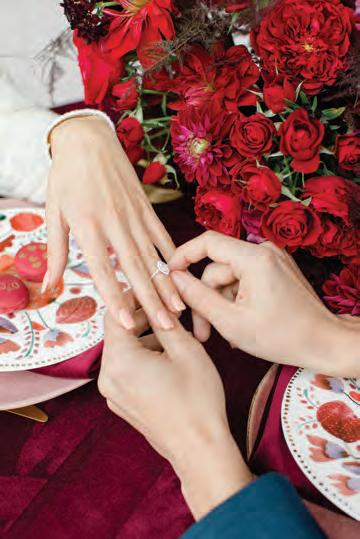
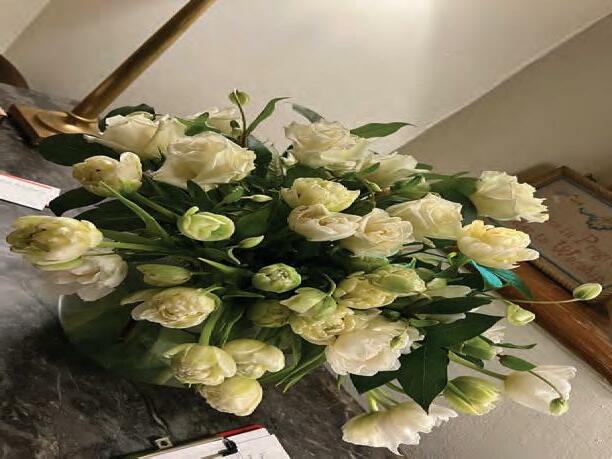



The first photographs of Black Indians appeared in local newspapers in the late 1800s. Some contemporary writers about the Black Indians noted that their suits resemble the garb of Plains Indians of the American West more than Native groups from the South, and they began to research the reasons and possible inspiMardi Gras Indians (1994), Michael P. Smith noted that Buffalo Bill’s Wild West Show toured the South for months in the late 1800s, spending almost a year in New Orleans. Smith theorized that shows like this may have inspired local African Americans—that perhaps, seeing other people of color performing with dignity and panache, they were inspired to incorporate some of the show’s “look” and iconography into their own masking traditions. Later, other writers about the Black Masking Indians have added other historical ideas and conjectures about the tradition. For example, the first photographs of Black Indians began to appear in local newspapers in the late 1800s (see Cynthia Becker, “New Orleans Mardi Gras Indians: Mediating Racial Politics from the Backstreets to Main , vol. 46, no. 2, 2013). New authors add evidence that the some of the songs may have connections to Native languages (see for example Shane Lief and John P. McCusker, 2019). Also, oral histories handed down by Black Masking

families and members of today’s tribes date the tradition to decades before Buffalo Bill’s 1884-1885 sojourn in New Orleans (see for example the book Fire in the Hole: The Spirit Work of Fi Yi Yi & The Mandingo Warriors, edited by Rachel Breunlin and published by The Neighborhood Story Project in 2018).

In any case, Black Masking Indians today are part of New Orleans' “cultural royalty”. Their suits take months of labor, as each masker hand-sews thousands of beads and sequins onto fabric, canvas, or cardboard forms. Next, there are ribbons, feathers, and plumes attached, plus the underlying garment itself. An Indian suit on average costs between $1,000 and $5,000 to make, often as much as $10,000, and can often take a full year to complete.






Chief Taylor has been sewing since he was a small child, and has memories of crawling around on the floor, picking up feathers and beads. “I started sewing when I was a little bitty kid. My mama’s brother was a Mardi Gras Indian, and he was also a real Cherokee Indian,” he explained. “And as time went on, I got good at it. I take it as a close hobby. It’s just a part of the culture, you know.” He usually makes a suit every other year, because of the labor and expense. In the years when he does not sew a suit for himself, he often makes a smaller, simpler suit for his grandson or goddaughter, because he likes to see the tradition carried on in younger generations. “I take my suit and I break it down and I make his,” Chief Taylor explained of making suits for his grandson Cam, who masks as a Little Chief. After he completed the purple suit that he wore for Mardi Gras 2018, adorned with flying creatures, including butterflies, he went on to stitch his magic again the next year—debuting a bright white suit studded with glass jewels in turquoise, beaded golden arrows, and other embellishments.
The pandemic halted the next occasions for celebrating his artistry, and since then Chief Taylor has been working on a suit that has yet to be debuted. We hope to see him step out looking “pretty,” as the Black Indians say, on Mardi Gras Day 2023—though if we don’t see him then, he says to keep an eye out for his new peacock suit in 2024.
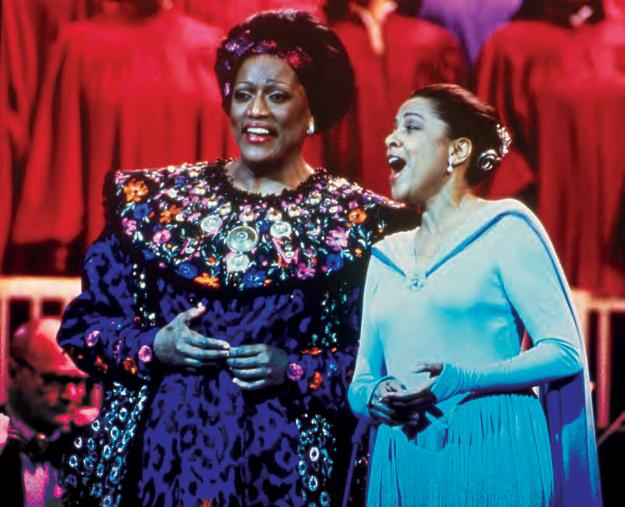
As a member of a “downtown” tribe originally from the Tremé, Chief Taylor’ s suits are three-dimensional and sculptural, whereas the “uptown” style features figurative tableaux created from flatter beadwork. “Me, I was taught the tradition by my uncle, his name was Thomas Sparks,” he explained. “This tradition, it’s in my family. My son, Charles Jr., he masks. And I make suits for my little grandson too.” He explained that he began masking as a child in the 1950s. Back then, “things were done the more traditional way,” said Chief. “You wait years while you slowly work your way up through the tribe … first you just a member, gotta show that you know how to sew and you’re committed. Next, you become a Spy Boy, later a Flag Boy. Eventually maybe you’re the third or second Chief.” Becoming a Big Chief, he explained, “that should take decades, but today, some make it go too fast.”
As a Black Indian works his way up through the ranks, a “Spy Boy” crafts a suit that is light enough so that he can easily move around. As the tribe parades, he notes what is happening up ahead—be it another tribe also out walking, oncoming traffic, or police presence—and runs back and forth to communicate with the Big Chief, to keep the tribe safe. A Flag Boy carries the organization’ s symbolic banner, announcing its name. The main body of the tribe includes its Queens, children, sometimes a Wild Man or Medicine Man (who guard a tribe’ s spiritual energy), possibly sub-chiefs, and finally the Big Chief. As tribes move spontaneously across city neighborhoods on Mardi Gras morning and St. Joseph’s night, or in pre-planned routes on Super Sundays, their encounters with other tribes involve elaborate greetings, gestures, and songs. Sometimes there are dance battles or verbal competitions praising or challenging the artistry of another individual’s or tribe’s suits.
Chief Taylor begins designing each suit by envisioning a color scheme and motifs, sketching his ideas, and drawing templates. While the “uptown” style of masking includes hand-beaded scenes that often reference Native American culture, such as depictions of spirit animals (eagles, wolves, horses, and more) or tableaux of battles between Native Americans and colonizers (with Natives as heroes)—the “downtown” style of suit is more abstract and given to three-dimensional representations of embellishments, often depicting Louisiana flora and fauna or sigils such as chevrons or the fleur-de-lis. But in recent years, many suit-makers in both styles have featured more Afrocentric themes, including portraits of Black educators and activists, Civil Rights heroes, African deities, and the use of cowrie shells as part of the beadwork.
When it comes time to craft the suit, Chief Taylor sets out to purchase the beads, sequins, and colored glass stones in the colors needed for his vision. During the year, he also saves household items such as Rice Krispies cereal boxes and plastic microwave ramen noodle bowls, piling them neatly and cleanly in his work room. The thin cardboard of the cereal boxes and the rounded form of the noodle bowls can be used as the underlying three-dimensional forms for decorative pieces such as butterflies, birds, medallions, or other adornments. These will later be attached to the various components of his garment. “What-

ever you find, you use, you know,” Chief Taylor said. “One guy masking with us, he took his mama’s curtains to make his Indian suit.” For the tunic top and pants that form the underlying base, he purchases textiles from stores such as Jo-Ann Fabrics. He prefers satin or other materials “with some shine to them.” Chief spends months and months hand-sewing rows and rows of beads, sequins, rhinestones, and colored glass gems, following the drawings and templates he has made. Once the beaded components are finished—the most intensive and meticulous part of crafting a suit—they are attached to base garments in layers. Piece by piece, Chief creates the front of the suit, including a moveable panel called the “apron” and smaller pieces called “patches,” as well as the back of the suit, its headdress or crown,” plus armbands, leggings, and boots. The final stages of suit-making include hand-sewing the feathered marabou” trim, as well as placing and attaching short- and medium-length goose feathers and the tall, colorfully-dyed ostrich plumes.
For his white suit of 2019, Chief Taylor chose to buy his marabou from Broadway Costume on Canal Street, where many Mardi Gras Indians shop. Next, as he asked me, I drove him to the best place to acquire satin ribbon, a wholesale florist shop in Arabi called Earl J. Doescher Co Inc. At home,

Chief Taylor ran the ribbon through a little machine that twirls it into rosettes and frills—used to adorn components of his suits. Finally, with the support of the community, Chief Taylor bought ostrich plumes—one of the most expensive suit materials.
This labor-intensive traditional art form is unique to New Orleans, and sewing techniques are passed from elders to youngsters in the community. Members of Black Indian tribes, be they a Big Chief, a Queen, a Wild Man, Flag Boy, or Spy Boy, all “sew, sew, sew,” as one of their traditional songs says, until it is time to debut each year’ s new suit.
The grand debut takes place on the morning of Mardi Gras Day, as tribes walk the streets of uptown and downtown in New Orleans neighborhoods including the Seventh, Eighth, and Ninth Wards, the Tremé, and Central City. Groups compete to see who has made the most dazzling, elaborate, and “prettiest” suits. Later, on St Joseph’s night in March and during three “Super Sundays” (Uptown, Downtown, and Westbank) in April and May, they take to our city’s streets again—marching, parading, strutting, greeting, competing, dancing, and singing call-and-response chants with lyrics such as:
Caller: “Hi-yo, hi-yo, hi-yo! I won’t bow down…”
Choir responds: “No, I won’t bow down…”
Caller: “I won’t bow down…on that dirty ground…”
Both: “Indians of the Nation! Of the whole wide creation! How I love, love, love….my Indian red! My Indian re-eeed!” h
Black Masking Indians can often be seen on Mardi Gras day at the corner of Second and Dryades streets Uptown, or near the Backstreet Cultural Museum in the Tremé.
Find a complete list of references used in this article at countryroadsmag.com.



On the edge of southern Mississippi lies Bay hSt. Louis, a small beach town filled with hantique stores, coffee shops, and restaurants that line the Gulf of Mexico. Hundredyear-old homes and vast oak trees border the stretch of coastline as the Gulf runs its ocean breeze through fine sand and patches of dune grass. With an estimated population of 10,000, this slow-moving town in Hancock County holds a classic seaside, Southern charm.
The last time I visited Bay St. Louis, though, all this allure was shrouded by the mist coating my windshield—the fog slowly moving along the St. Louis Bay Bridge like a cluster of lost ghosts. The damp, humid air sat heavy like a wet towel. As I drove closer to my destination, I passed by an old shopping strip, reminiscent of the ones shown in Spaghetti Western films. A vacant movie theater from 1927, known as A&G Theater, sat crammed between abandoned and renovated buildings.
Finally, I spotted the faces of Albert Fairconnetue (the first president of the Hancock County NAACP), Etta James, and Lucious Spiller—painted beside three young girls performing at a Mardi Gras Ball—on the mural outside of 100 Men Hall. I parked my car beside a neighborhood home across the street and approached the establishment, which is painted three shades of blue with bright magenta entryway doors, which owner Rachel Dangermond opened with a smile as I crossed the same threshold passed over by some of our nation’s most iconic blues musicians.

There isn’t a single blank wall inside 100 Men Hall. Framed paintings overlook the bar: a work by Darrin Butler, a portrait of a Black Cuban woman smoking a cigar, another of James Booker. On one of the partial walls jutting out from the center of the room, two young Black boys look on, one wearing a shirt that reads “We are our ancestors,’” and the other: “wildest dreams.”
The venue was founded in 1894 by a group of twelve Black men known as the Hundred Members Debating Benevolent Association, who came together to raise money for the community’s burials and medical costs. In the decades before the Hall was built in 1922, the property was used as an open-air pavilion for fundraising concerts. What was originally meant to be a space for the civic-minded organization quickly transformed into a safe gathering place for Black people in Bay St. Louis. Throughout the twentieth century, 100 Men Hall hosted wedding showers, plays, Mardi Gras balls, and performances like the Manless Wedding, where women would dress in male drag. In the 1930s and ‘40s, the entertainment hotspot became an esteemed music venue on the Chitlin’ Circuit, drawing legendary acts like Ray Charles, James Brown, James Booker, B.B. King, and Irma Thomas. This continued throughout the through the deepest depredations of the Jim Crow era and the heights of the Civil Rights movement. And then, in 1982, the hall closed.
Music was changing, with new trends like vinyl and DJs capturing the imagination of a new generation. The
100 Members Debating Benevolent Association separated and sold the building to the Disabled Vets of America. Just before Hurricane Katrina in 2005, the organization sold the building to a couple with intentions to turn it into an art gallery. When Hurricane Katrina damaged the Hall, the Federal Emergency Management Agency threatened to tear it down.
Knowing the historical significance of 100 Men Hall, local historical restorationist and musician Jesse Loya convinced his wife Kerrie White that they should purchase the property. In the years to come, the couple would resurrect the Hundred Members Debating Benevolent Association as a 501c3, and win a $110,000 grant from the state of Mississippi to renovate the historic building. Their efforts resulted in the establishment of a historical marker by the Mississippi Blues Commission in 2011, recognizing the site’s important history in Mississippi blues culture.
Dangermond never expected to own a blues hall in Mississippi. Before moving to Bay St. Louis, she lived in New Orleans and worked as a facilitator for the Welcome Table—a Winter Institute initiative with Mayor Mitch Landrieu’s office to address systemic racism in the city. She was also holding writing workshops in her home. Then one day, a friend of hers—who knew she had a desire to live in a beach town—told her that 100 Men Hall was for sale.
“I was like, no,” Dangermond laughed. “Why would I want to live in a blues hall? You know, that makes no
sense.”
Still, she decided to pay 100 Men Hall a visit. Entering the historic space, she immediately felt inspired to apply her passions for writing and equality to preserving the rich history of the venue. While acknowledging the history of Black Mississippi—a winding and complicated story of racism, segregation, and Jim Crow— Dangermond also wanted to highlight a more triumphant chapter.

“I think that the space itself tells a story, and the story is Black self-reliance and a self-directed community,” Dangermond said. “Here along the coast and particularly in this town, there is an amazing abundance of Black culture and history.”

Since 2018, Dangermond has been working to preserve that history through renovations and various events. A “Tin Shed” has been built behind the venue, which hosts creative retreats and artist residencies. After restoring the hundred-year-old floors, Dangermond commissioned big name artists to paint the venue’s iconic murals. Recently, in recognition of the venue’s centennial, musician Jimbo Mathus helped to produce a marionette film that tells the story of the historical century. Today, the institution is cherished as one of the few still-intact African American landmarks along the Mississippi Blues Trail, and hosts regular programming including live performances, artist residencies, writing workshops, fundraisers, and more.
“I think a lot of people, even here in Bay St. Louis, don't understand how significant this place is,” Dangermond said. “We just hope that it gets more attention because it's bigger than me. We're the real deal. The history is here.” h
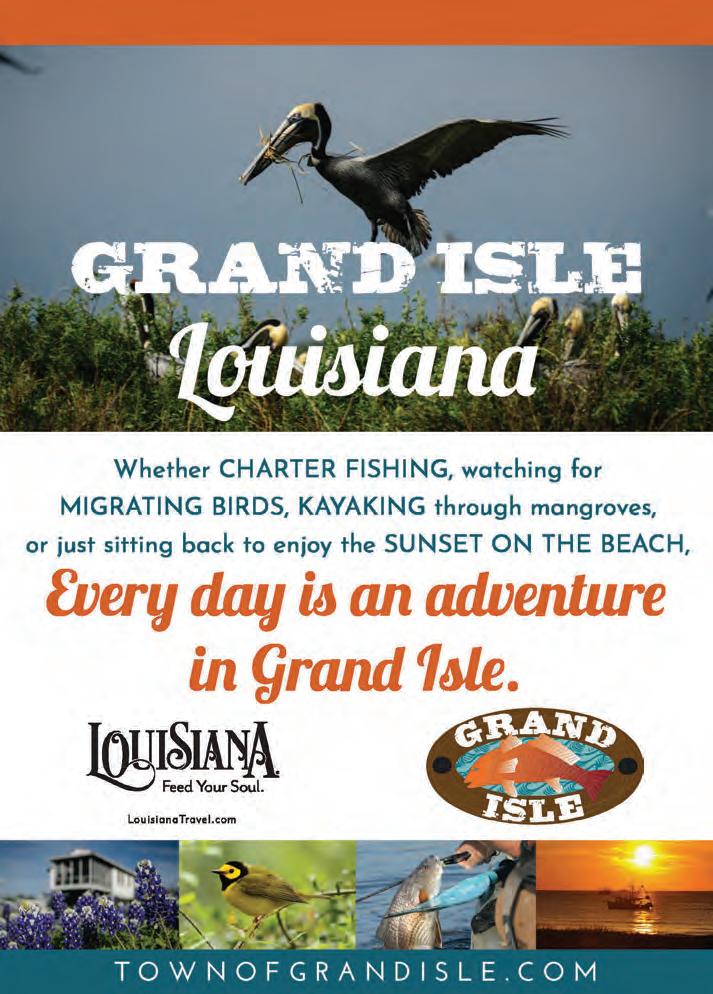
Plan your visit to 100 Men Hall at the100menhall.com. This month, upcoming events include programming for the Centennial Harlem Renaissance Weekend February 3–5, and a film screening of American Justice on Trial on February 9.

Images courtesy of Rachel Dangermond.


We launched on the first Saturday of the year. Through the January chill, we languidly paddled around the rotting canopy of fallen trees, called strainers; beside water-smoothed limbs that pierced the rippling surface, snags; and past gurgling feeder streams, swirling eddies, sandy beaches, and steep multicolored clay banks. We saw turtles and blue herons and a lone blinking deer. A hawk screeched in the distance and buzzards circled overhead. We scared up countless ducks and a beaver or two. The river was as wild as BD Markey had promised: virtually untouched and unspoiled. You might even call it pristine.
Markey is the owner and operator of Guided Canoe Tours, a venture he started in 2020 to share his love of the Pascagoula River Basin, the last remaining unregulated major river system in the lower forty-eight states. What this means is that along the more than two dozen rivers and creeks that constitute the watershed, there are
no dams—other than those built by beavers—nor levees, channeling, or dredging. These living bodies of water meander through a patchwork of private and protected public lands, some 9,600 square miles of it, including 37,000 acres of Pascagoula River Wildlife Management Area and nearly half a million acres of De Soto National Forest, and eventually drain into the Gulf of Mexico.
Before the arrival of European colonizers and their forced removal of the area’s Indigenous tribes in the nineteenth century, the Choctaw occupied much of this land. The Chickasaw claimed a piece, too, as did the Biloxi and Pascagoula. According to Markey, there were settlements at many of the basin’s confluences, ideal places to fish and trade goods with passersby.
Experiencing a river so physically un-altered by the region’s tumultuous history, and overcoming the unforeseen obstacles it presents is, for Markey, precisely the point of these adventures. In the city, it is easy to cultivate a sense of control in our lives. But out here, anything can happen. A surprise shower might develop in a moment’s notice. Massive logs jut out and block the path. You have no choice but to deal with these “problems” as they come, navigate around them, or beneath them, and continue on. Aside from the occasional piece of plastic (infiltrating even this wildnerness) you can go miles without seeing any evidence of modernity. It is easy to imagine you have traveled a thousand years back in time.
I signed up for a three-day solo tour, just Markey and me. Earlier in the week, heavy rains raised the water level eight feet, but by the time Saturday came around, the river had leveled out. Sunday, the rains returned. We hunkered in our tents all morning and decided to camp on the bank another night. After the rain finally ceased, we sat in camping chairs and ate sandwiches and tomato soup for lunch, played cards, did some yoga, meditated, read a while, and gathered firewood until evening arrived—at which point we shared another meal and too many s’mores and conversed beside a crackling fire. The next morning, we discovered that the water had risen at least three feet—revealing before our eyes exactly how reactive these waters are to the elements.
Long ago Heraclitus pointed out that one never sets foot in the same river twice, that after each experience, the river and the person have inevitably changed. The snags we encountered yesterday are, with luck, submerged today and thus easier to navigate, and perhaps easier to forget. See how a river makes a tidy metaphor for life?
Markey got into this business after a life-altering experience in 2016. Late one night, while riding his bike to his New Orleans home, he was sideswiped by a car—a hit and run that remains unsolved. The damage was severe: collapsed and punctured lungs, a broken orbital socket and collarbone, and other injuries besides. He couldn’t get oxygen to his lung and swiftly went into a coma, but somehow, the next day he woke up. When he gathered his bearings, he looked inward and reassessed. Coming so close to death emboldened him to change what he didn’t like about his life—an awakening in more than one sense. He quit his desk job, got sober, and began to feel like a different person altogether.
Growing up in western Massachusetts, Markey had always been comfortable on river water. After recovering from the accident, he decided to try his hand as a whitewater rafting guide on the Deerfield River in New England. The next year, he bought a kayak and traveled to Minnesota to the source of the Mississippi River and from there paddled 2,400-miles down to New Orleans. “At the end of that trip, I realized I just want to continue living outdoors,” Markey told me. “I felt more alive, and healthier, and satisfied.”
Over the past few years, Markey has worked as a park ranger all over the country, from Vermont to Wyoming, returning to New Orleans at the end of the season to run his canoeing tours. They go from October to May, usually a couple of times a month.

Markey said that four to six guests makes an ideal group; more than that can get a little crowded. On launch day, usually a Friday morning, the guests meet in New Orleans and Markey drives everyone two and half hours east to whichever river he’s chosen for that trip. When they complete the route on Monday afternoon, Markey drives everyone back to New Orleans. He provides all the gear, the food, cookware, and expertise. All you need to bring are your toiletries and a few changes of clothes. Markey doesn’t disclose the names of the rivers he guides, nor the exact locations of his tours—the better to keep these places less known, less impacted.

Markey first came upon the Pascagoula River Basin eight years ago, an entire year before the accident, and has since found healing in these murky waters. He’s begun to think of his trips as retreats, rather than mere tours, and even once invited an eco-therapist to lead meditation sessions. The basic idea is for guests to “get away from their city life and get into the emotional and spiritual connection that humans have to the natural world,” he said, “immersion, not visitation,” and he is there to facilitate that transformation.


“Everything kind of slows down,” said Erik Johnson, a former guest on Markey’s tours. “It lets your mind wander and delve into things otherwise you wouldn’t because of your normal grind of life … It was a big mental recharge.”


In one of our beach conversations, Markey elaborated on his vision. “Instead of just passing through here and taking pictures,” he said, waving at the line of maple and cypress above the mossy banks, “they’re living in it, living with it, for three or four days.”

Another important aspect of Markey’s mission is to provide a space for groups who haven’t always felt welcome in outdoor spaces, namely BIPOC (Black, Indig enous and people of color) and queer-identifying folks. With this in mind, Markey has scheduled trips that intentionally cater to these groups. “I think the outdoors should be a welcoming place for everybody, because everybody can benefit from it,” he said. “If it’s more comfortable for marginalized groups to come on a tour exclu sively for marginalized groups, then I’m happy to offer that.”
On these excursions, mornings usually begin with breakfast, which Markey pre pares and cooks, followed by silent meditation and a brief yoga session. Cleaning up is either handled by volunteers, or otherwise the guests play a spoon toss game to decide. And then the camp is broken down, leaving no trace, everything repacked in the canoes for the next leg. It’s almost like a mobile floating summer camp.
On the third and final day of my private trip, we paddled through an epic morning fog. The swollen river was luminous, reflecting a rising sun. The water moved swiftly but we paddled anyway, entering a long serpentine stretch. Some of the curves looped around like a horseshoe and on the other side of one of them we came upon a small waterfall. We followed the bubbling current on the edge of the curves, like some antediluvian express lane, a truly exhilarating experience invigorated by the mystery of what lay beyond the next bend. Such experiences are harder and harder to find. h
Abbeville, LA
Vermillion Parish Tourist Commission 53
Baton Rouge, LA
Allwood Furniture 20 Artistry of Light 49 Arts Council of Greater Baton Rouge 10 Becky Parrish Advance Skincare 47
Blue Cross Blue Shield 18 Calandro’s/Select Cellars 25 East Baton Rouge Parish Librar y 56
Elizabethan Gallery 42 Louisiana Public Broadcasting 46 LSU Museum of Art 30 LSU Online and Continuing Education (OLLI) 16
LSU Rural Life Museum 19 Manship Theatre 24 Opera Louisiane 16 Pinetta’s European Restaurant 38

Wilson & Wilson Attorneys, LLC 51 Window World of Baton Rouge 21 Woman’s Hospital Cancer Pavilion 13
WRKF 89.3 FM 51
Brookhaven, MS Brookhaven Tourism Council 29
Ferriday, LA Brakenridge Furniture 29
Greenwood, MS Experience Greenwood 41 Grand Isle, LA Grand Isle Tourism Department 49
Hammond, LA Tangipahoa Parish CVB 55
Jackson, MS Visit Mississippi 5
Lafayette, LA Books Along the Teche 41 Allwood Furniture 20
Mandeville, LA
St. Tammany Home & Remodeling Show and Food Fest 14
Mansura, LA Avoyelles Tourism Commission 35
Morgan City, L A Cajun Coast CVB 43
Natchez, MS Brakenridge Furnituren 29 Katie’s Ladies Apparel 42 Monmouth Historic Inn 33 Murray Land & Homes Realty 9 Natchez Convention Promotion Commission 32 Natchez Pilgrimage Tours 17 Old South Trading Post 11 SuKaz Jackets at Olivina 6 United Mississippi Bank 32
New Iberia, LA Iberia Parish CVB 27 Shadows on the Teche 27
New Orleans, LA Historic New Orleans Collection 15 Louisiana State Museums 26 New Orleans Public Library 3
New Roads, LA City of New Roads 46 Pointe Coupée Parish Office of Tourism 7
Opelousas, LA
St. Landr y Parish Tourist Commission 37
Plaquemine, LA
Iber ville Parish Tourism Department 23
Port Allen, LA
West Baton Rouge Museum 38 West Baton Rouge CVB 39
Scott, LA
Bob’s Tree Preservation 42
St. Francisville, LA Artistry of Light 49 Barlow Fashion 2 The Magnolia Cafe 45 Town of St. Francisville 45
Vicksburg, MS Visit Vicksburg 47
Ville Platte, LA
Evangeline Parish Tourist Commission 37
Zachary, L A Lane Regional Medical Center 34

SSuch characters can be traced back to French Caribbean sculpture artists Jean Luc Toussaint and his wife Vanessa Guy-Toussaint, who lead the street performance troupe Aso Mawon Matnik out of Schoelcher, Martinique. The group, a sort of ‘krewe’ in their own right, participated in a cultural exchange during Mardi Gras 2019—facilitated through NUNU Arts and Culture Collective and the Consulate General of France in New Orleans—which sent them on a whirlwind Louisiana Carnival experience that included marching in the Muses parade and participating in two Acadiana courirs. Their time here also included a series of workshops in which the artists shared traditional Martinique mask-making techniques, taught primarily in French, across Acadiana.
The couple will return this year just in time to assist interested Louisianans in creating one-of-a-kind, showstopping regalia for this year’s Mardi Gras celebrations. The three-day workshop hosted by NUNU will include instruction on how to creatively construct the stunning 3-D masks signature to Martinique tradition, as well as conversations on the connections and distinctions between Caribbean and Louisianan Carnival celebrations.
Carnival arrived in Martinique much the same way it did in Louisiana, with the French Catholic settlers of the seventeenth and eighteenth centuries. In Martinique, though, the tradition was additionally influenced by the island’s population of enslaved Africans—whose imitations of the French settlers’ lavish celebrations served as a mechanism to honor the folklore and traditions of their homeland. Carnival as it is practiced today in Martinique officially began in 1870 after slavery was abol-
Carnival masks as early as October, “and finish the day before,” laughed Guy-Toussaint. While many individuals and groups in Martinique make and wear masks, what Aso Mawon Matnik and other similar associations do is an act of cultural preservation, committed to the artistry of traditional mask-making. “Our particularity is that we have a kind of way of making masks that are very personal, very elaborate, very artistic,” said Guy-Toussaint.
The group has traveled all over the world, particularly to places of Creole culture, offering traditional mask-making workshops—and this will be their third visit to Louisiana as artists-in-residence at NUNU. This year’s workshop will invite mask-makers to create a disguise that doubles as an authentic expression of their “true identity”—an unexpected twist on the way Mardi Gras façades are typically perceived.
“When you wear a mask,” explained Guy-Toussaint, “the true version of yourself is between the real face and the mask … it’s not one or the other, it’s in between. Because you exchange something very very intense with people when you wear this mask. The way they are seeing you is transforming the way you feel about yourself. It’s special.”
Beatrice Germaine, the Executive Director of the French American Chamber of Commerce in New Orleans, said that besides the gorgeous skull mask she took home in 2019, she gained a new perspective on cultural representation and participation across Carnival celebrations. “Suddenly, it’s not just a costume, but you’re representing something symbolic, and the Caribbean tradition as a whole,” she said.

ed to return them to NUNU—rumpled and soaked in sweat and mud and beer as they are, the marks of Mardi Gras upon them—for an exhibition at Saint Luc French Immersion and Cultural Campus this spring. Oral history will be incorporated, too, when everyone is invited to share a meal and storytelling session around the entire experience.
The knowledge and context shared in such a cultural exchange shifts one’s entire worldview, said Germaine. “It just brings explanations of the traditions we have here, just talking together … and it’s keeping this process alive, the discussions alive and modern and contemporary alongside issues we have now.”
For the Toussaints, experiencing Louisiana’s version of Carnival has been its own enriching experience. “As a Creole person, I cannot say exactly why, but I think there is some kind of familiarity here,” said Guy-Toussaint. “A lot of little things I can recognize. I feel very at home. It’s really a culture here, and it has been a very, very important experience for me. It’s widened my vision of what it is to be Creole.” h
The Martinique-Style Mask-Making Workshop Retreat will take place from February 10–13 at NUNU Arts and Culture Collective in Arnaudville. $150 for members; $450 for non-members (with the option of becoming a NUNU member for as little as $25 annually). Learn more at nunuaccollective.homesteadcloud.com.
Lear more about the Toussaints at jean-luc-toussaint.com.


